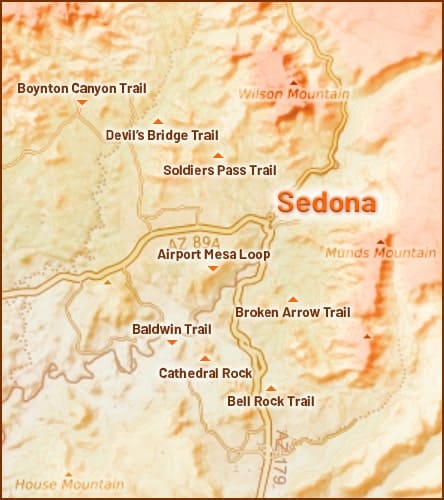To be clear, there are 100 trails to hike in Sedona so just picking the 8 best Sedona hiking trails as the best is difficult and somewhat arbitrary. The (8) trails we’ve chosen are from trails we’ve actually hiked but there are many others we hope to experience somewhere down the road. We did meet many locals on our hikes that agree with our assessment and did, in fact, recommend other trails on this list. One of the frustrating things about Sedona is the paths have different names and are not always clearly marked. The locals have different names for certain trails and you can’t rely on signage to be consistent so you’ll definitely want to have a trail map with you or a reliable trail app.
There are hiking and biking trails all over Sedona and each virtually guarantees beautiful views from any direction. So you really can’t go wrong no matter where you choose to hike. Our list of the best Sedona hiking trails includes walks that are part scenic, part challenging and geared for experienced hikers who enjoy the views as much as the exercise. You’ll encounter rock scrambles, deep gorges, rocky paths and dusty red rock dust that’ll stain your socks and legs. To keep it simple we’ll start at Bell Rock and more north ending with Boynton Canyon.
Click on the trail name below to see some great pictures and to learn more about each trail.
Bell Rock Trail

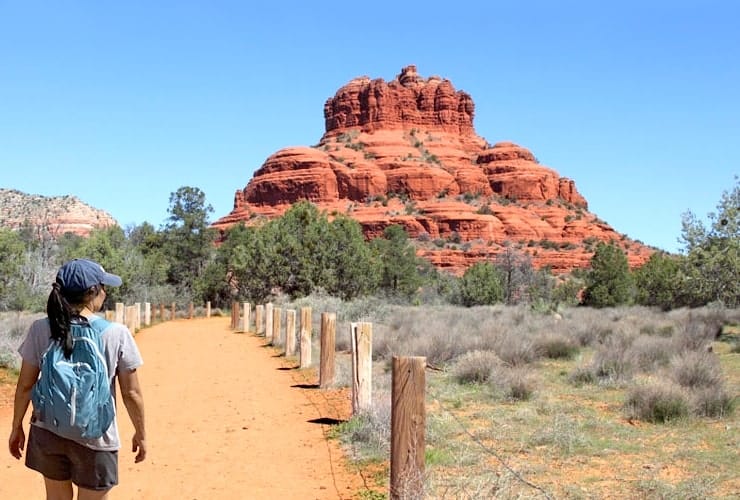
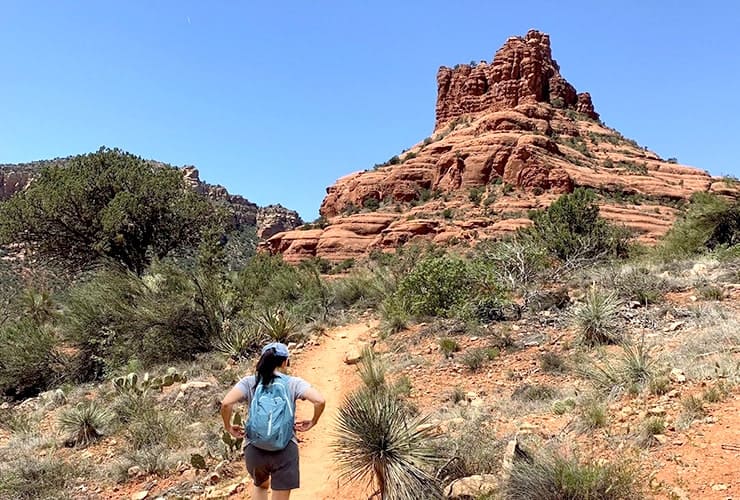
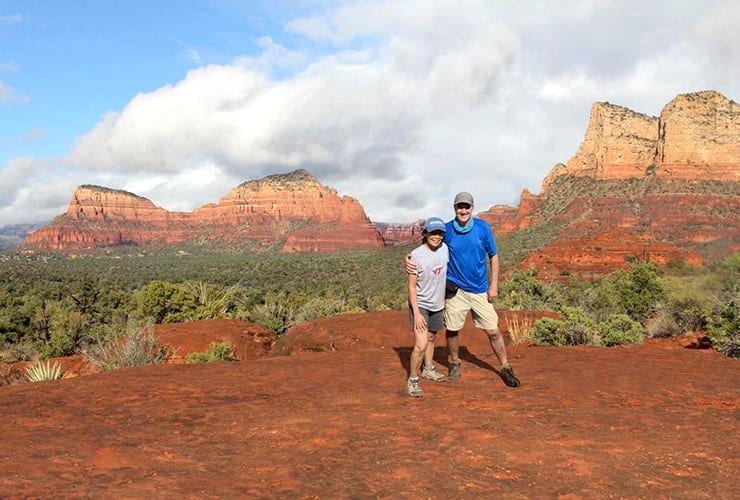
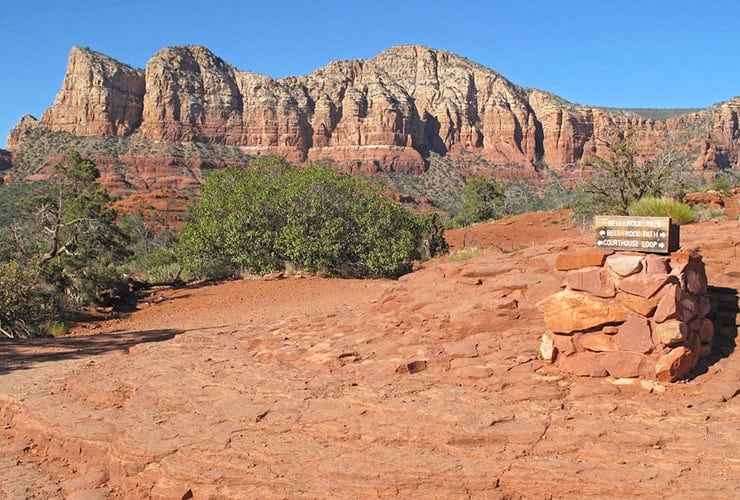
You can access the Bell Rock Trailhead from the Courtyard Vista parking area just off the AZ-179. Ironically, some of the best views of Bell Rock are actually from the parking lot but hiking up the north side of Bell Rock will provide you with some spectacular views. The higher you go . . . the better the views. Just follow the signs for Bell Rock Climb and be prepared for a moderate but rocky ascent. The hike isn’t difficult but it is definitely rocky. You’ll go around 700’ (213.4 m) in elevation to the lower plateau where the views are amazing. From here you can see Courthouse Butte, Cathedral Rock, Rabbit Ears, in the far distance beyond Cathedral you’ll see Cockscomb. You can proceed higher if you choose. Just be aware that there are no signed trails as you ascend further and it’s really only recommended for more seasoned hikers. This is a very popular trail so get there early so you can get a parking space.
Baldwin Trail

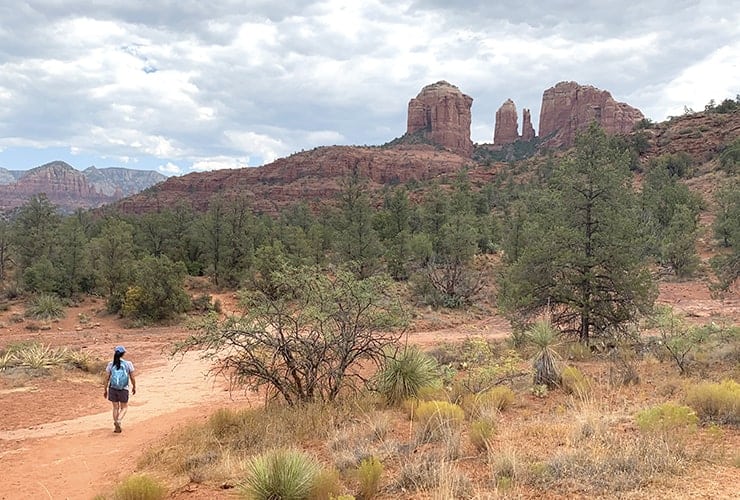
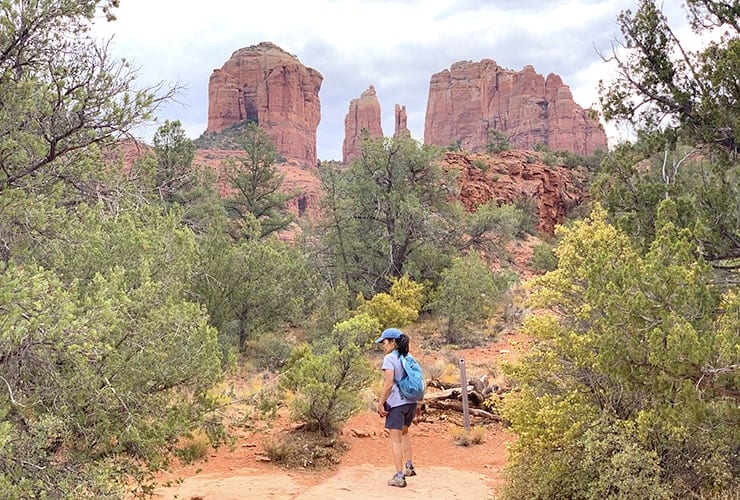
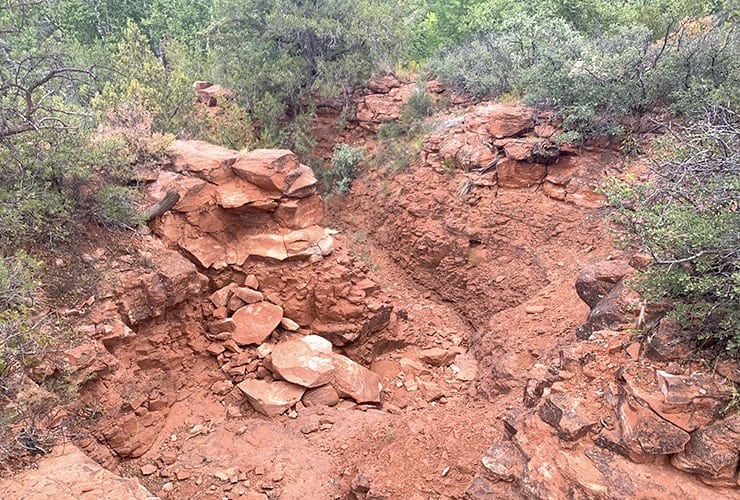
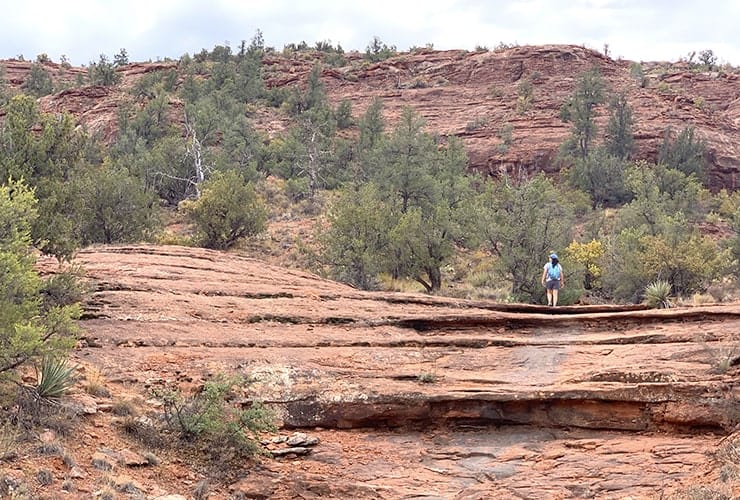
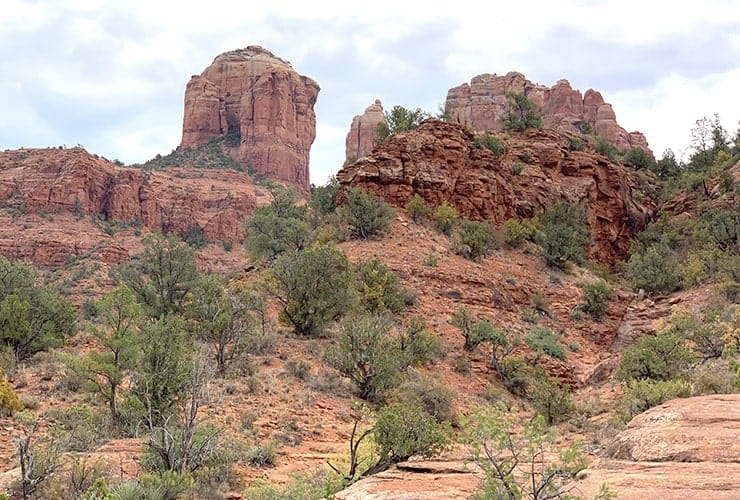
Baldwin Trail was our first hiking experience in Sedona and quite memorable. The trailhead for this 3.3 mile (5.3 km) round trip loop is across the street from the parking area and leads to a wide open red rock dust path with Cathedral Rock visible in the distance to your southeast. It’s easy to get caught up in the natural beauty all around you but be mindful of staying on the path. We wandered off trail a few times though were able to find our way back pretty easily. The hike itself is rated easy but also provides little shade so be sure to wear a hat, apply some sunscreen and stay hydrated. The loop brings you to an elevation of 3,950’ (1,204 m) but only an increased elevation of 100’ (30.5 m).
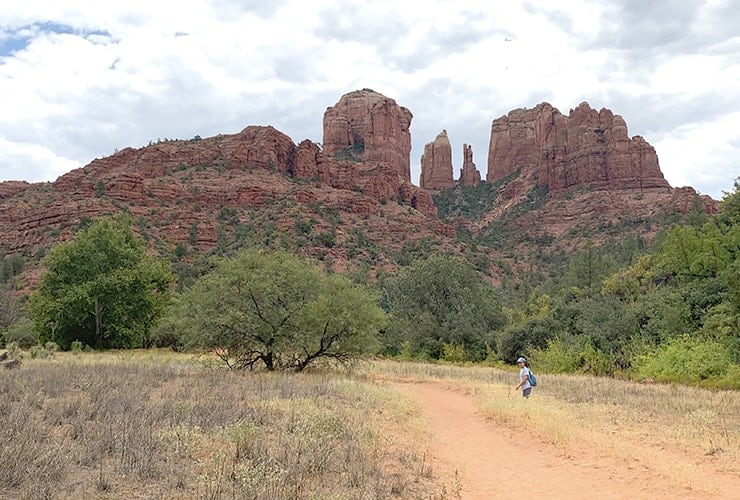
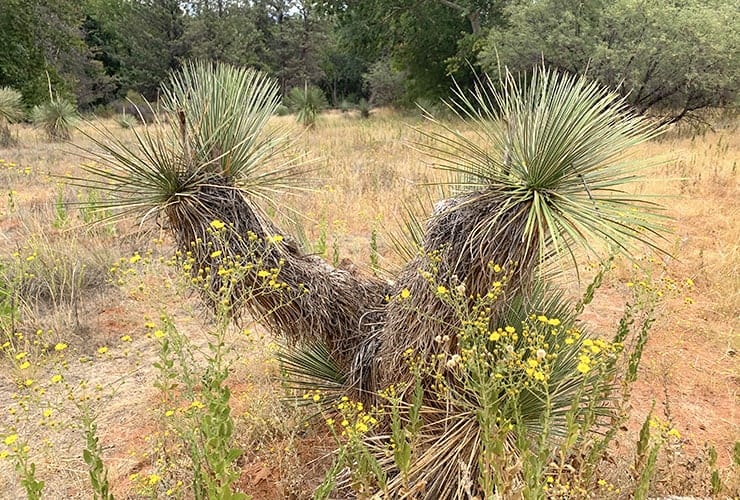
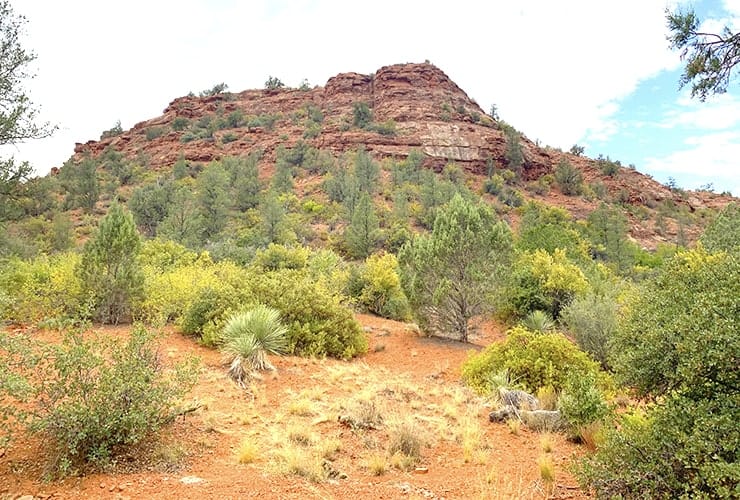
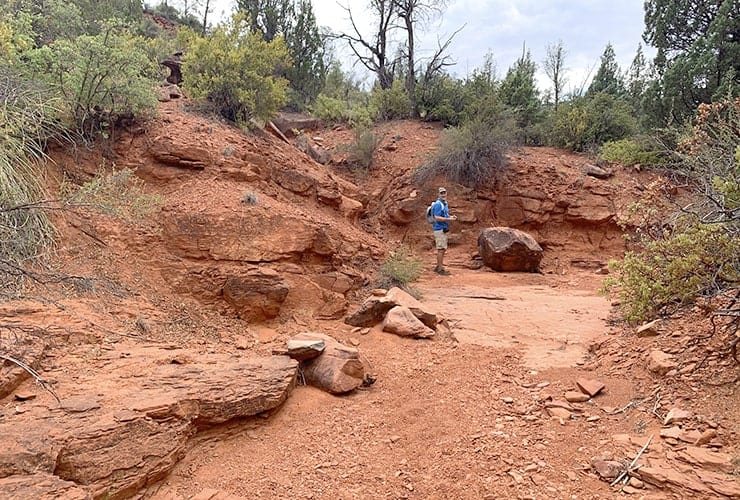
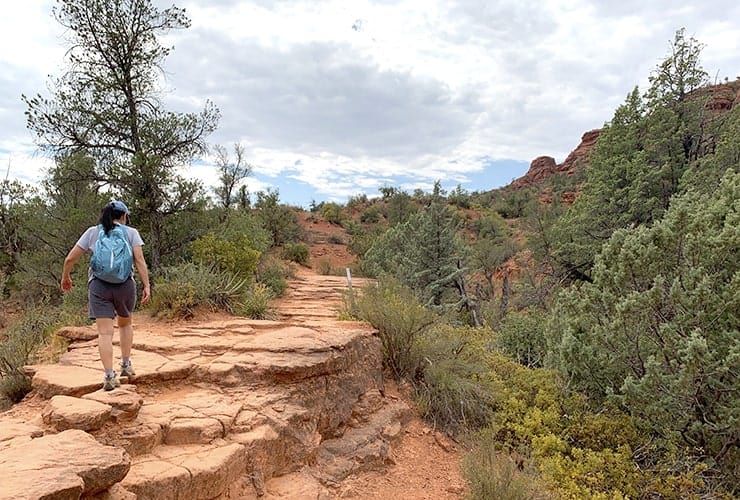
At about the .3 mile (.48 km) mark you have the option to veer northwest (Crescent Moon) and head down to a small accessible opening to Oak Creek or continue on a few more minutes to connect to Templeton Trail which will bring you to Cathedral Rock. Be mindful that the Templeton sign is only visible if you look behind you after you pass a single “BALDWIN →” sign. We continued on Baldwin and enjoyed a never ending stream of cactus, Juniper trees, manzanita bushes, small canyons and dry creek beds along paths that go from flat to hilly in a moments notice.
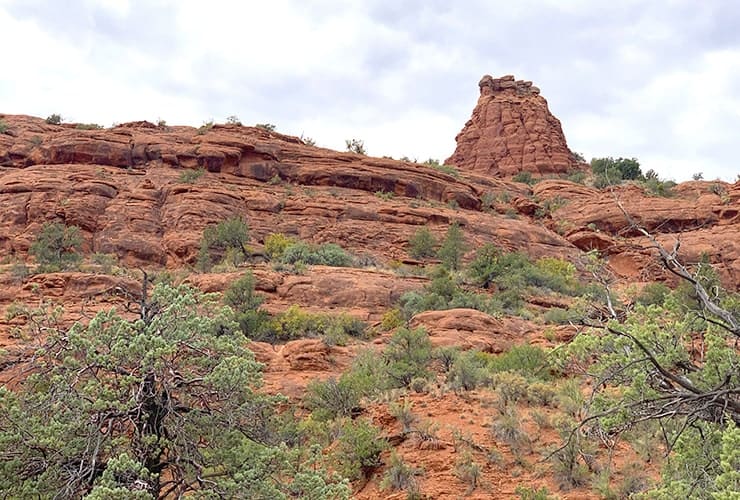
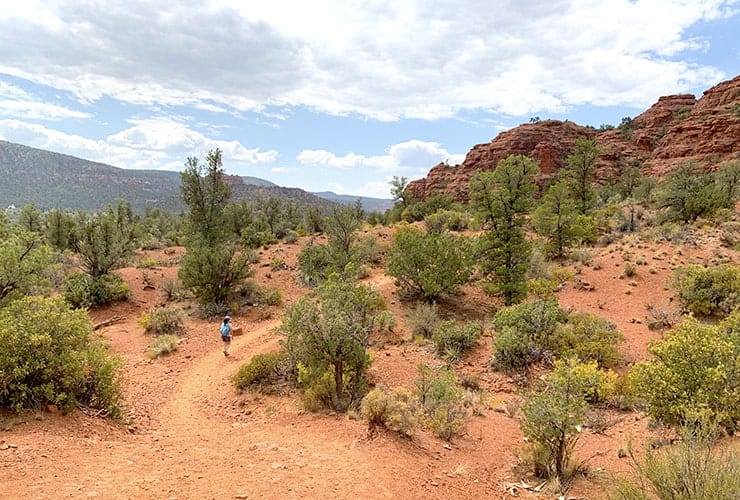
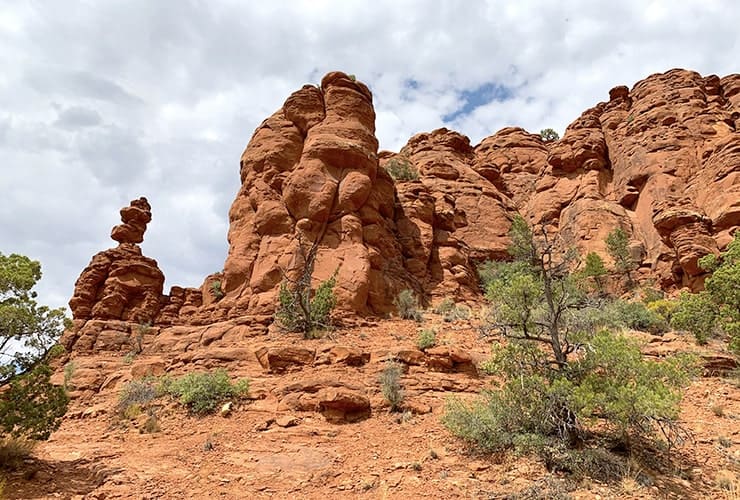
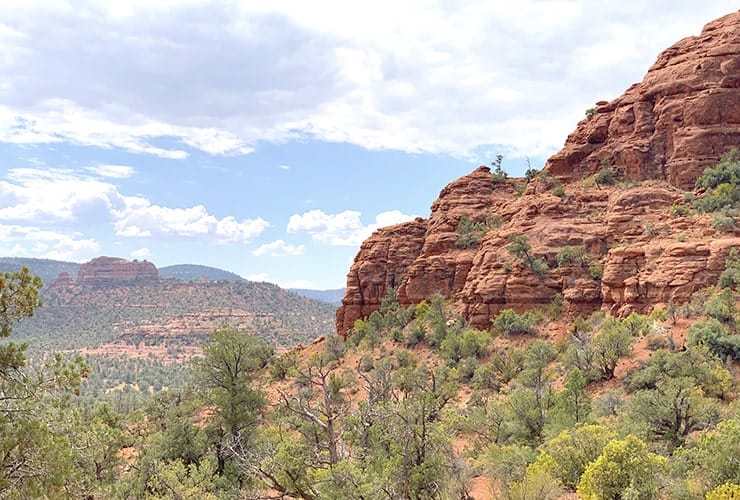
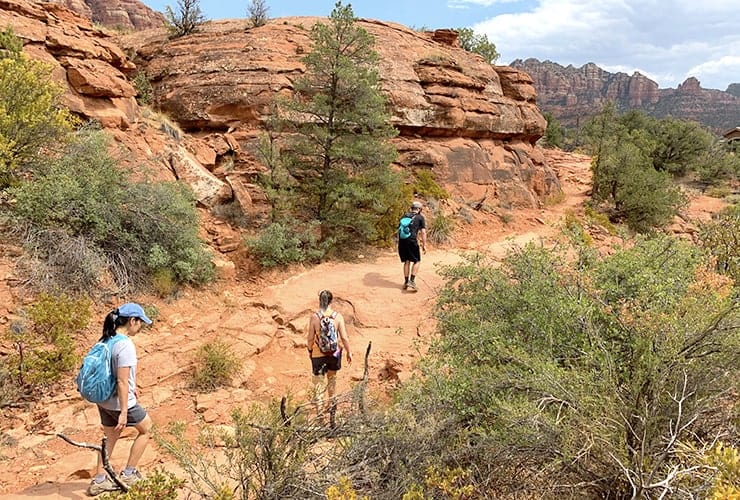
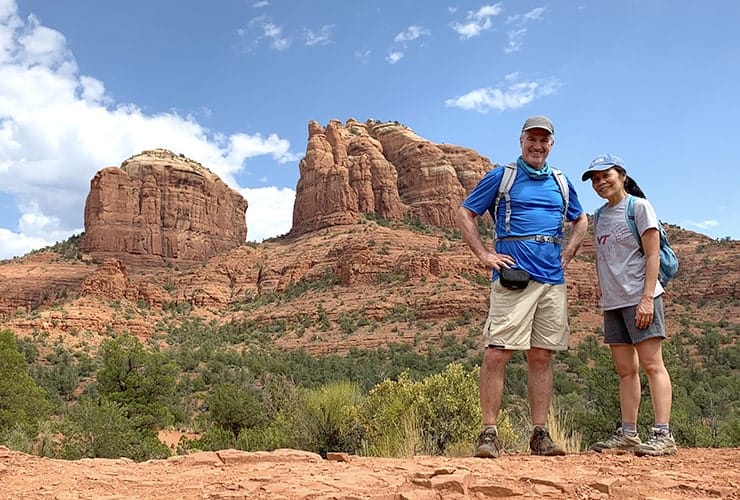
While there are some up-and-down slopes none of it is very strenuous. Along the way there are several marquee picture spots with Cathedral Rock in the background. If you have an interest in rock formations you’ll really enjoy the Baldwin Trail. There are rocks in all shapes, sizes, colors and elevations. To the west you see several fantastic red rock formations like Schnebly Hill Sandstone, cross-bedded sandstone, a balanced rock and a few very cool canyons. The trail also offers a nice variety of path types, some narrow and framed by trees, others more open and airy and a few vista points perfect for pictures.
On our list of best Sedona hiking trails Baldwin Trail ranks right at the top. There was so much natural variety around every corner from mountain peaks and views of Cathedral Rock to deep caverns and a various vegetation. Bring lots of water!
Templeton Trail (Cathedral Rock)

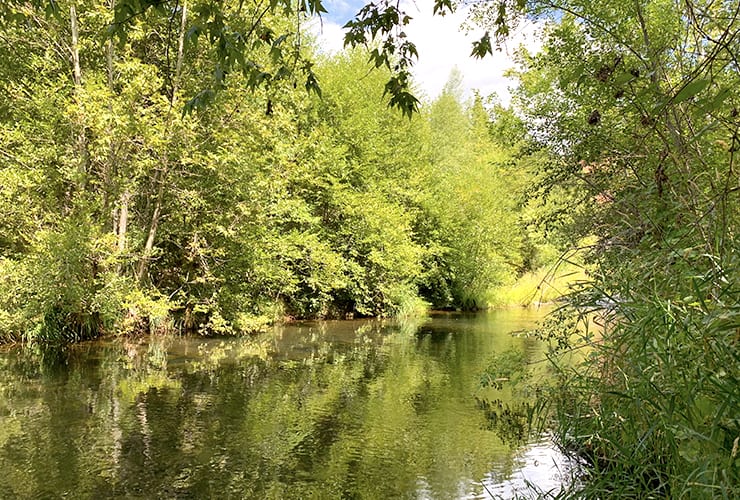
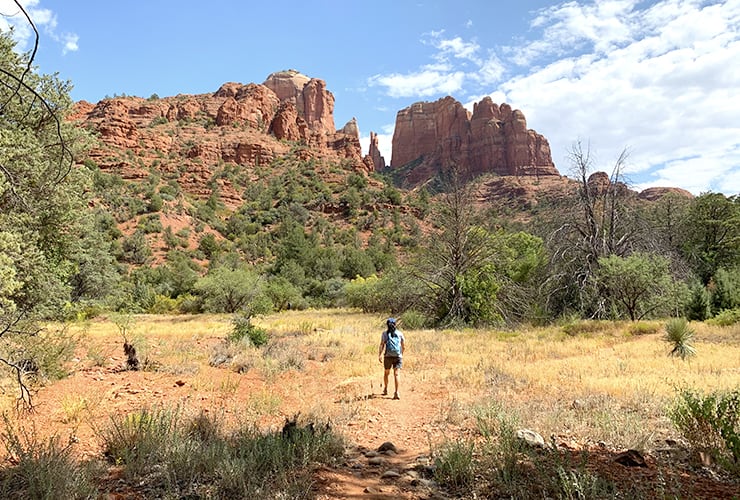
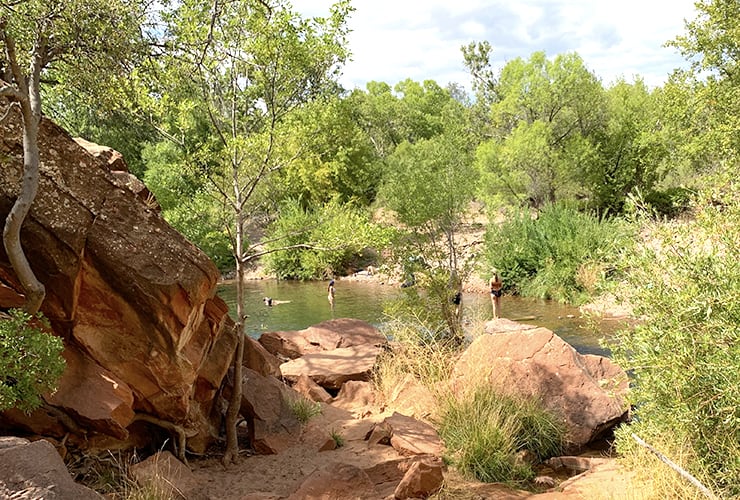
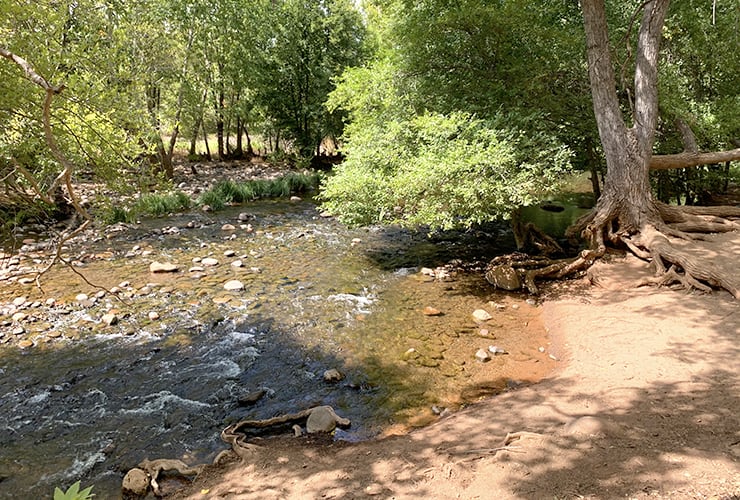
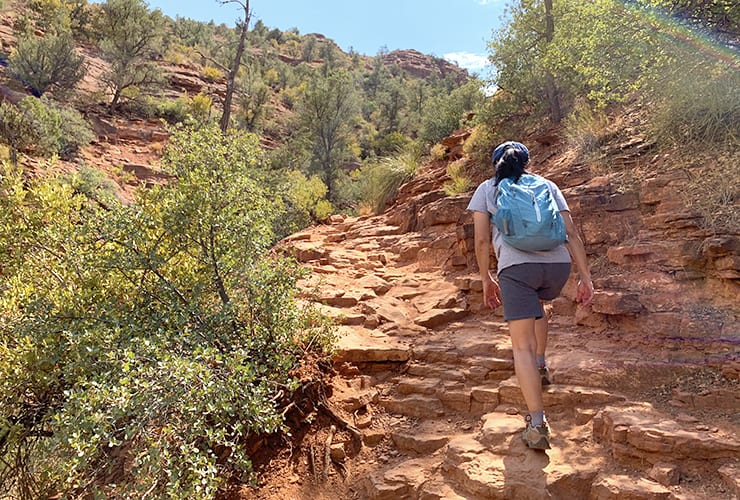
After walking Baldwin Trail, we took the Crescent Moon trail down to Oak Creek and took a break. The water was cool and it gave us a chance to cool down our heads (and legs) before continuing on to junction with Templeton Trail towards Cathedral Rock. Templeton runs parallel to Oak Creek until you hit the Red Rock Crossing vortex. Across the creek sits Buddha Beach, a favorite summer teenage hangout. You’ll recognize the vortex by the large twisted Juniper tree at the water’s edge (though some claim the vortex is actually at the base of the mountain). From here the trail moves away from the water and starts its ascension up to the base of Cathedral Rock. The trail is rocky, with little shade, winding its away around the base.
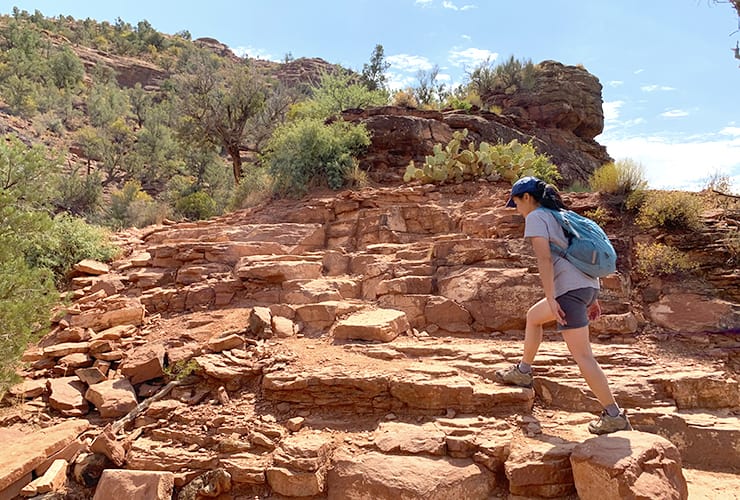
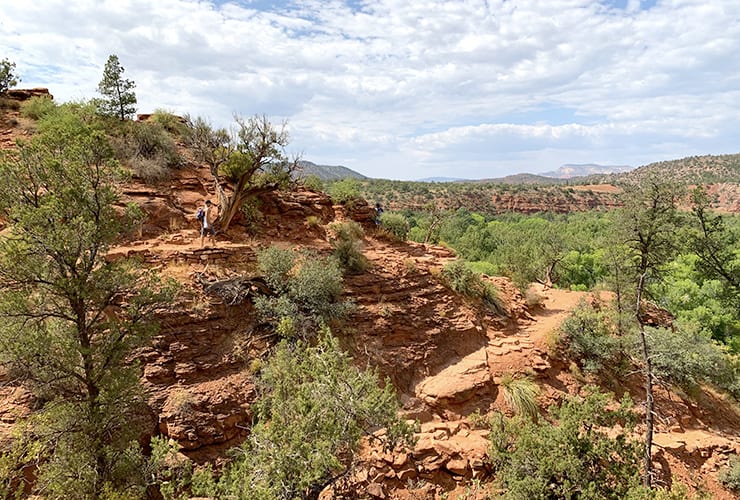
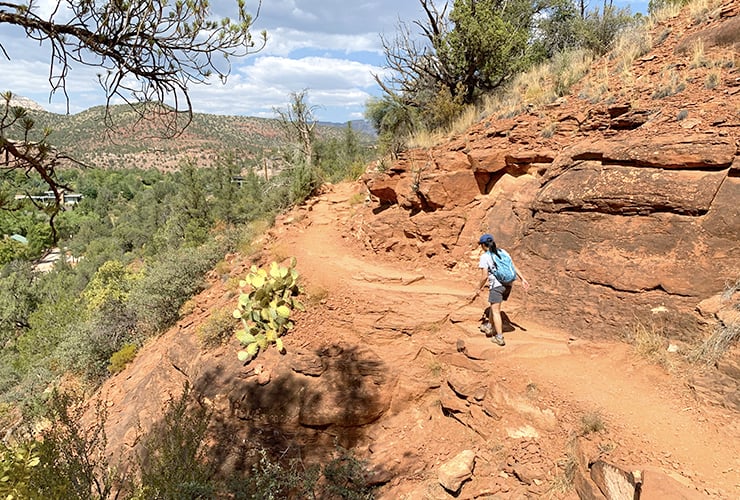
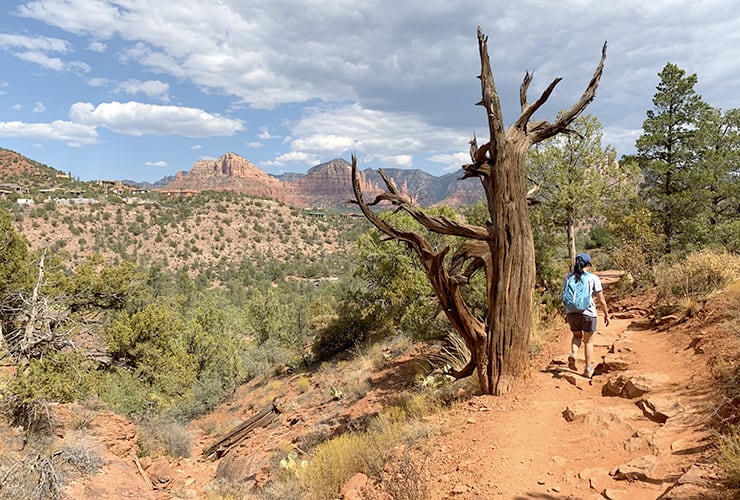
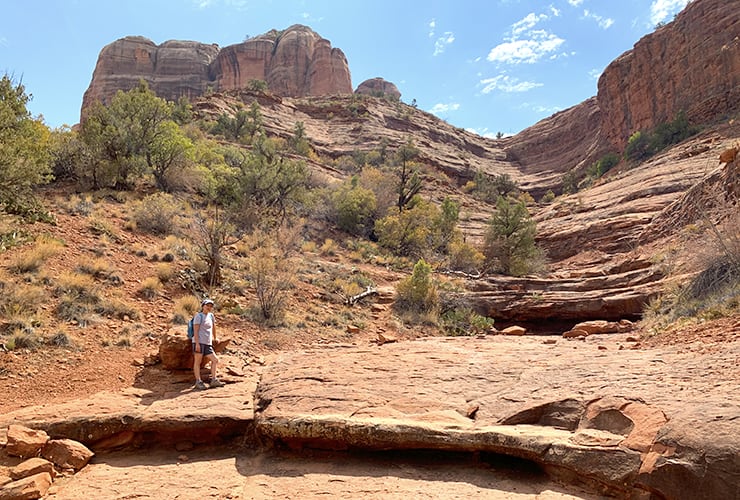
The trail is notable for its rock stairs, series of winding switchbacks, gnarled Juniper trees, deep canyons and valley views. Along the way there are amazing views both of Cathedral Rock above and to the north including Capital Butte, Snoopy Rock, Courthouse Butte and Bell Rock.
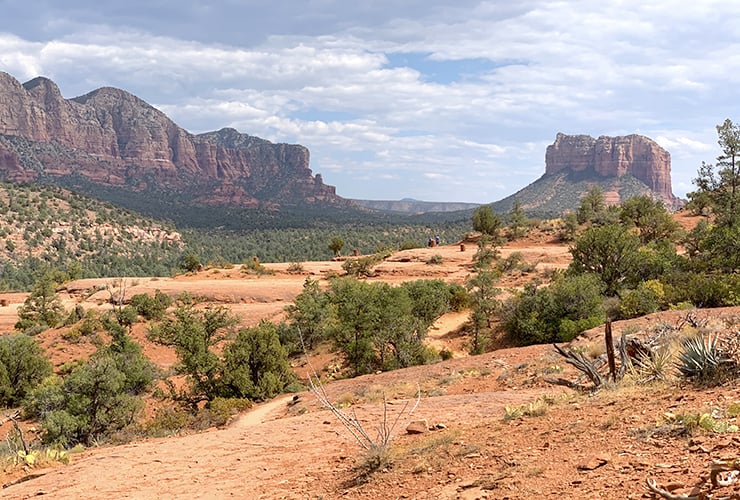
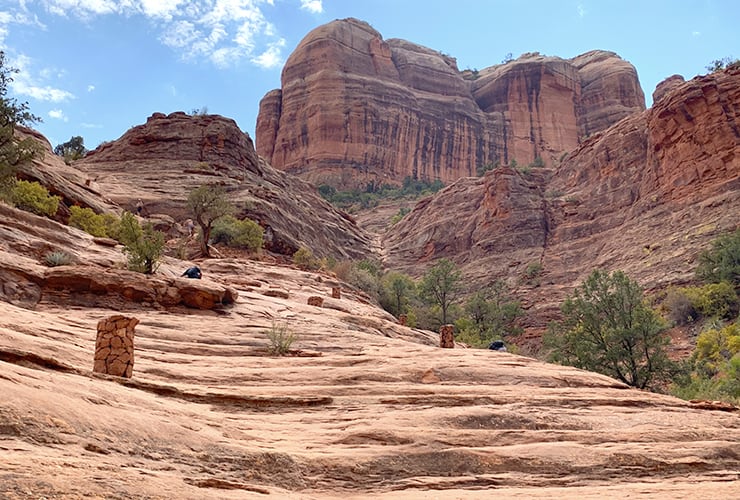
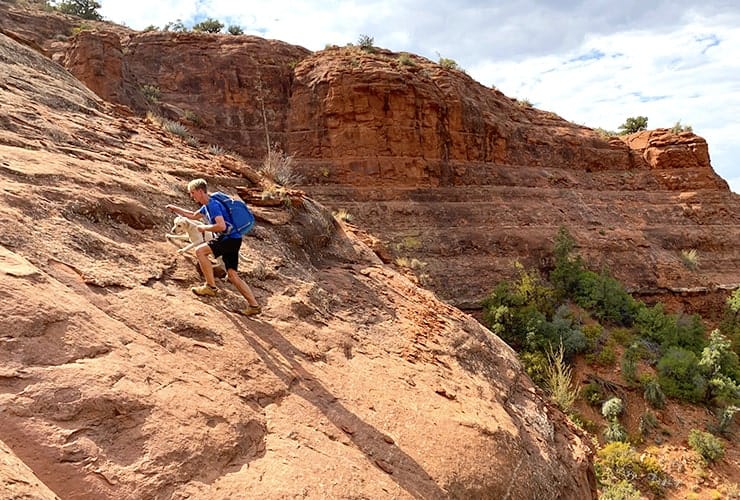
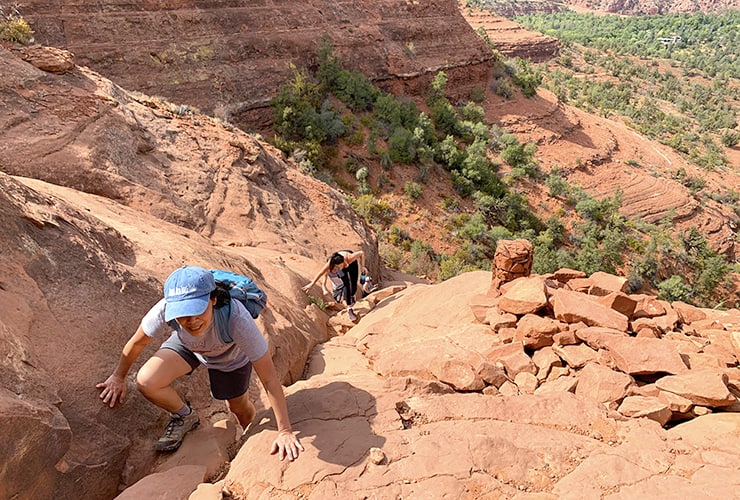
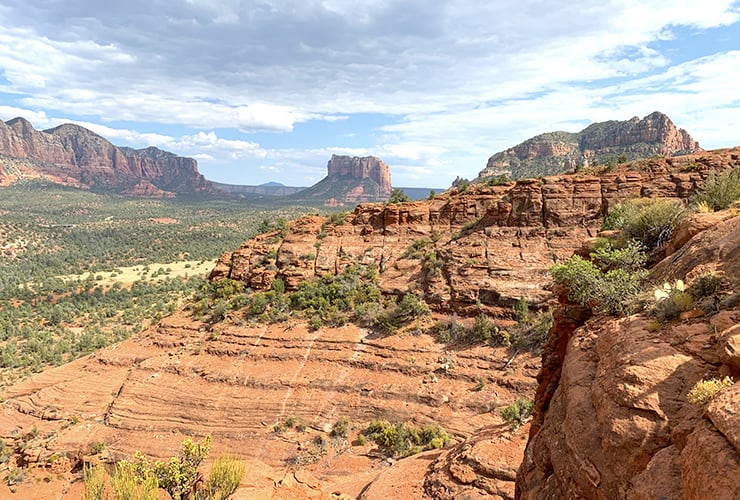
Eventually you’ll get to a flat rock plateau which allows for an amazing view of the valley below and the northern face of Cathedral Rock. This is a great place to take some pictures and rest as you prepare to keep climbing up. On your way up are a series of rock scrambles and steep smooth inclined rocks that look more intimidating than they actually are due primarily to the number of available hand and foot holds. It’s a lot easier with hiking shoes but we saw one hiker in flip-flops and another with his large dog! There are stages that, depending on the time of day, allow you to rest in semi-shade and get re-hydrated. You can go up as far as your stamina, and common sense, allows . . . the higher you go, the better the views. Going down is easier than it looks as well but definitely take your time.
Broken Arrow Trail

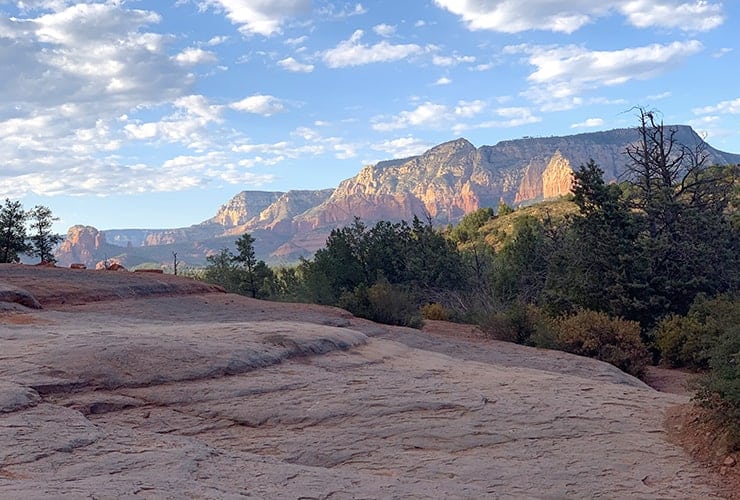
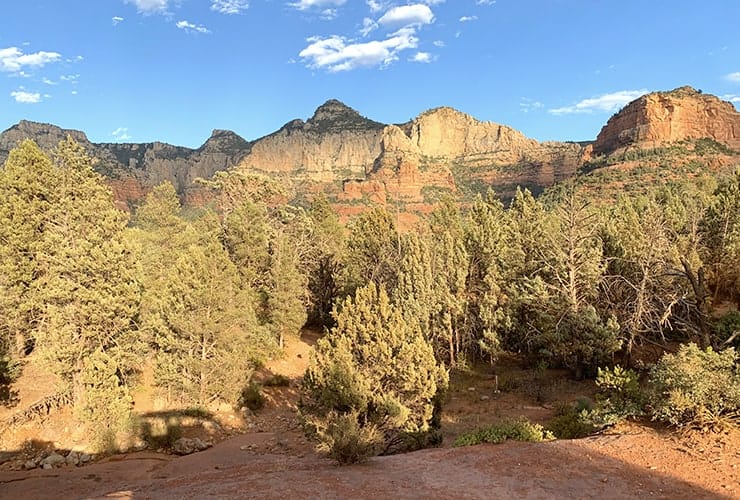
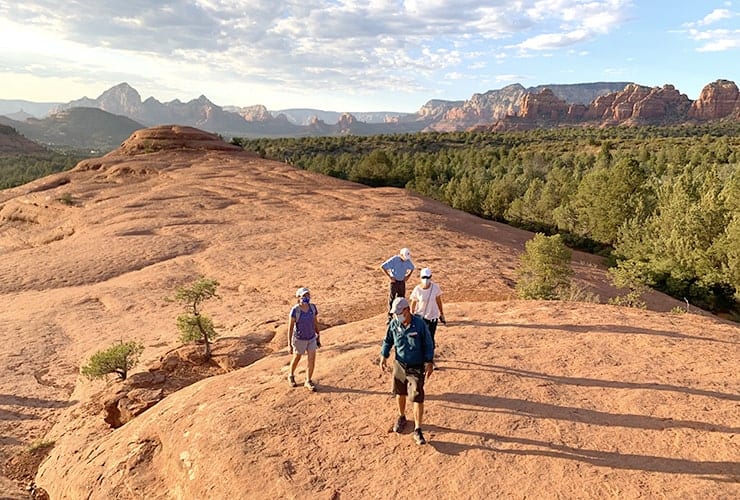
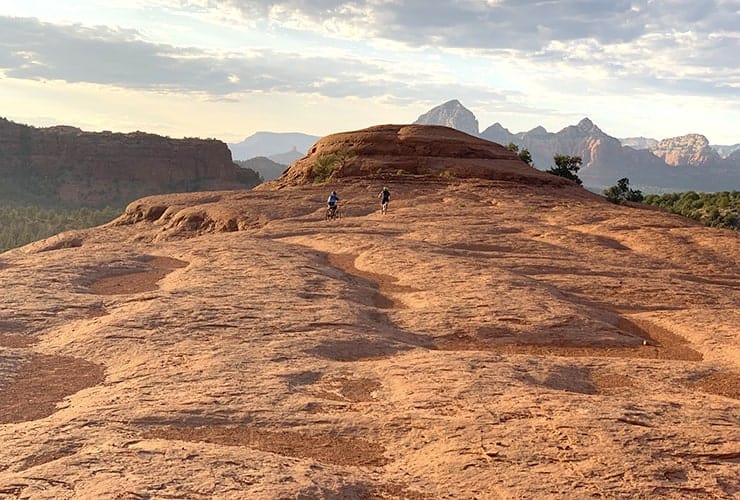
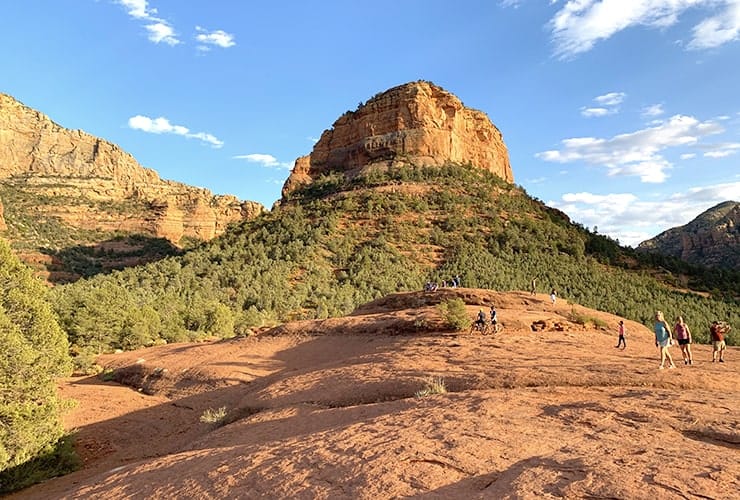
We decided to forego hiking Broken Arrow and to instead explore it by taking a sunset Pink Jeep Tour. We didn’t regret our decision one iota. One of the advantages of tours is the information gathered from your guide. Most in Sedona are excellent and, even better, are more than willing to answer any questions. Our guide, Peter, was a bit corny but an absolute fountain of information. As we headed south through the clusters of cypress and yucca along the Broken Arrow Trail the late afternoon sun was already reflecting off the red rocks producing a wide array of stunning colors. Our first stop was Submarine Rock, a truly amazing long, oval-shaped plateau, that was once completely under the ocean water. The views are spectacular as you look into a valley full of Juniper trees and include the massive Capitol Butte, Wilson Mountain and the impressive peaks of Munds and Lee mountains.
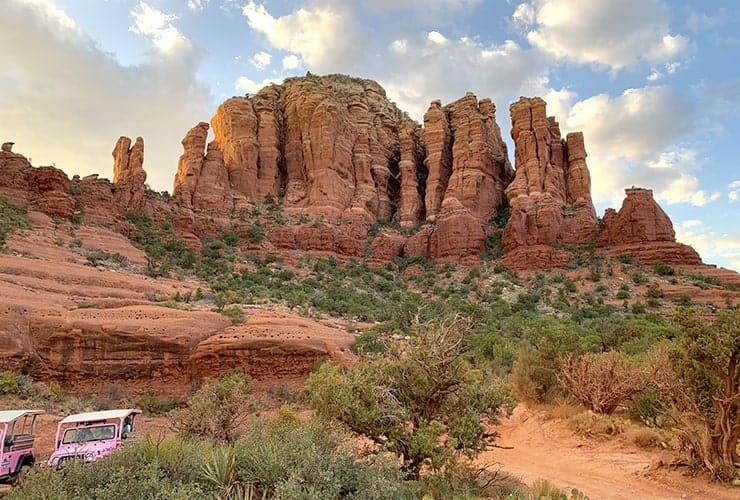
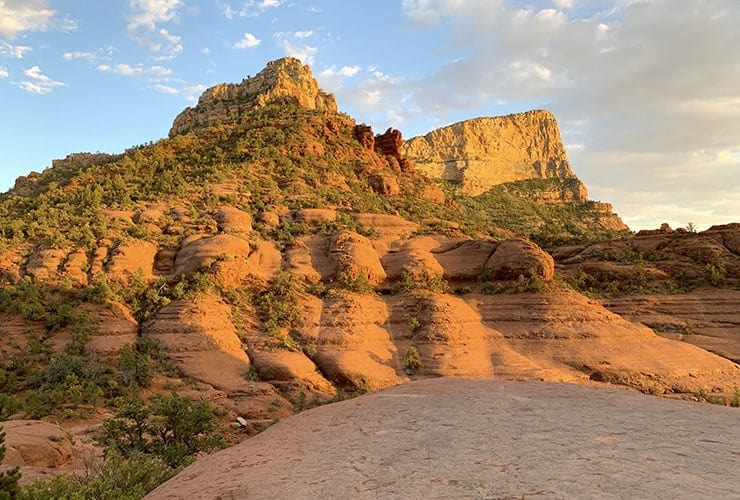
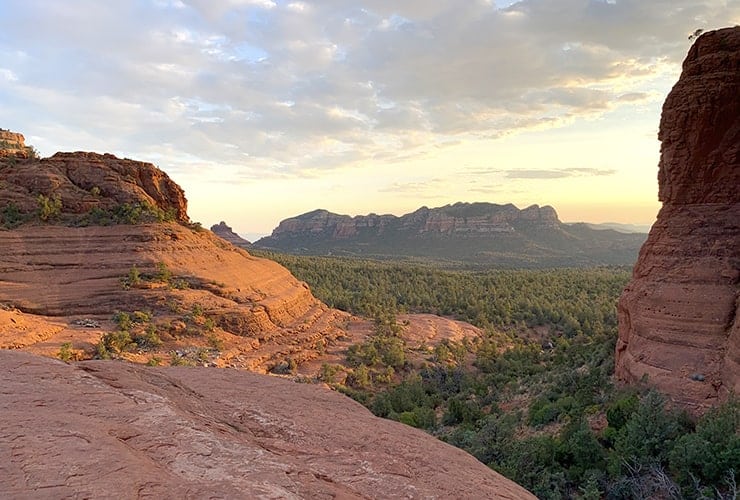
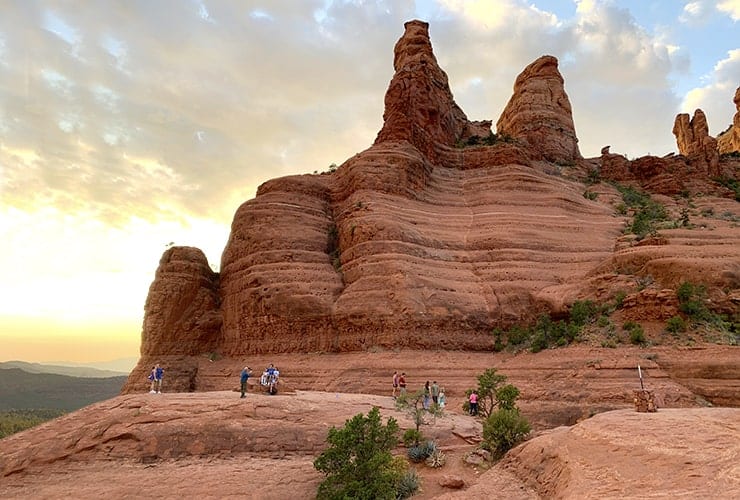
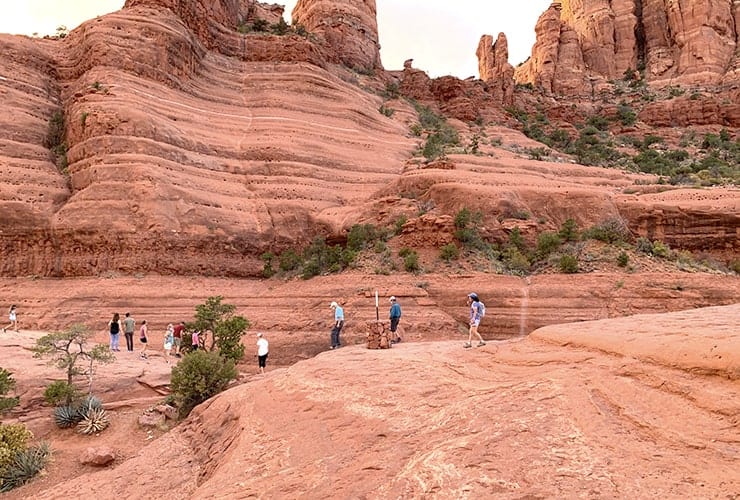
We next proceeded to Chicken Point and its craggy monoliths. Now the early evening sun began washing the red rock with color creating an almost orange glow on the formations striped with aged layers of sediment. The view looking down into the valley, framed on both sides by huge red rock formations, was simply breathtaking. Looking up you can see the infamous White Line which runs parallel to the ground about halfway up the cliff face. Daring (or crazy) extreme mountain bikers ride this thin white line across the face of the cliff for thrills . . . crazy.
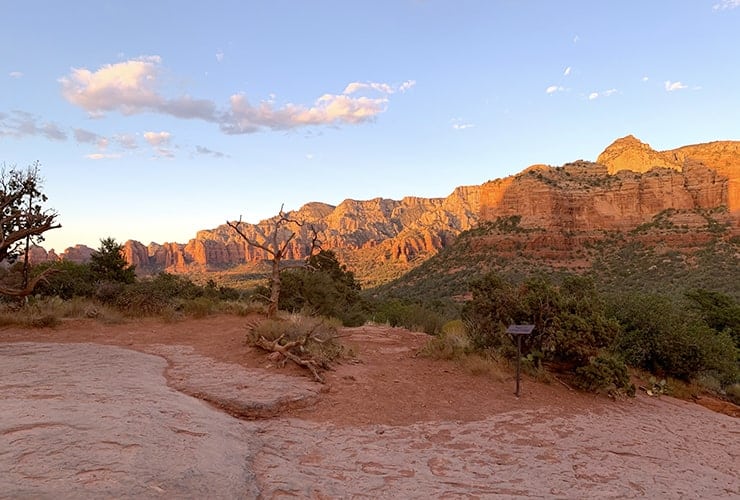
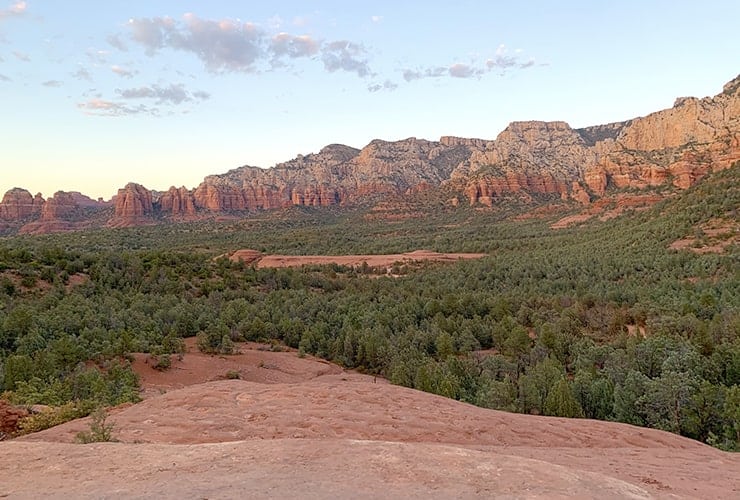
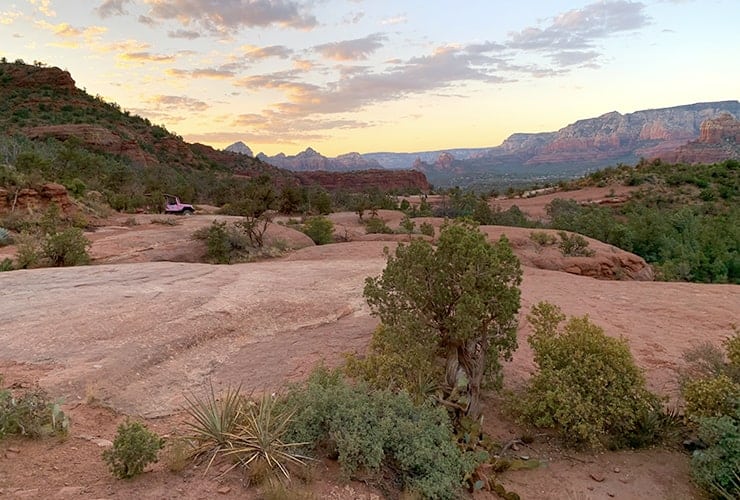
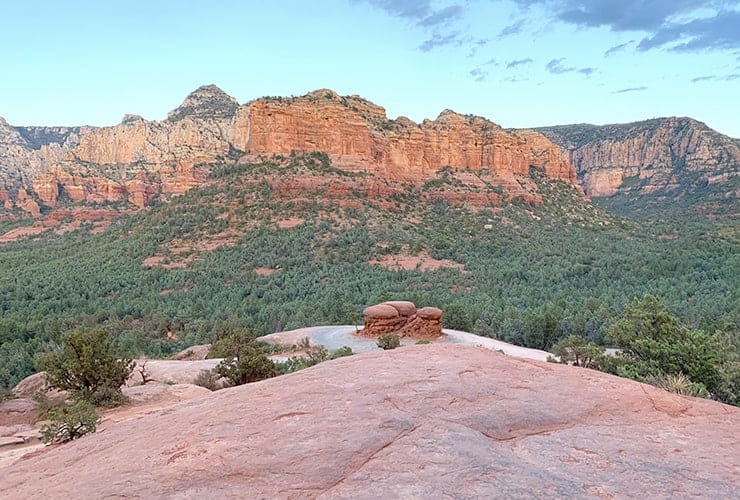
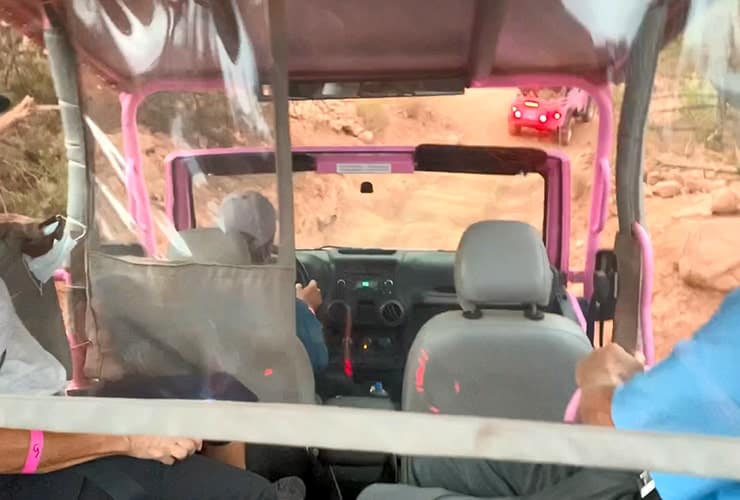
On the way back we got a fantastic long-range view of Submarine Rock and understood better how it got its name “floating” within a sea of Juniper. We continued our bumpy ride traversing a seemingly endless array of rounded rocks until we arrived at the so-called “Point of No Return”. This is one of the tour’s highlights . . . an almost 90° descent down a smooth rock face that is truly exhilarating. You’re never in danger but it’s still an unusual sensation like going down the steepest part of a roller coaster very slowly. By the time we arrived back at Pink Tours it was almost dark so we enjoyed a really nice walk back to the Inn Above Oak Creek with a stop to have dinner in the Tlaquepaque Arts & Shopping Village.
Airport Mesa Loop

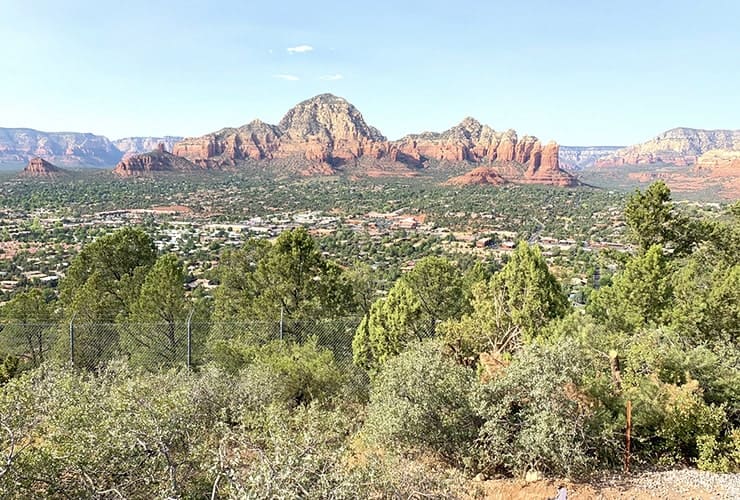
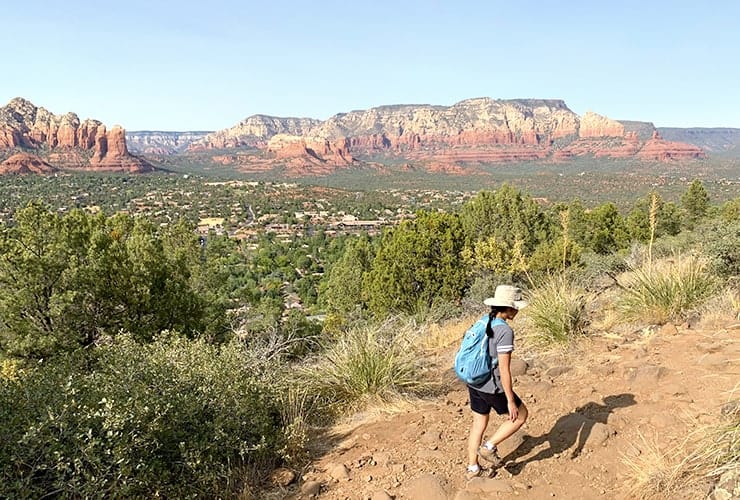
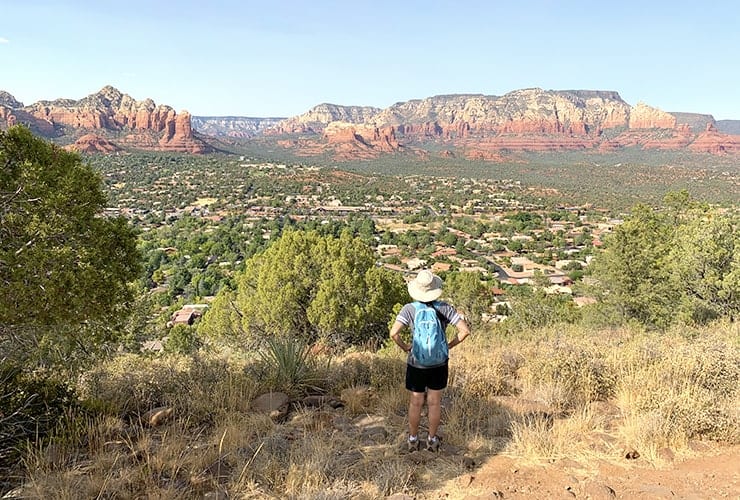
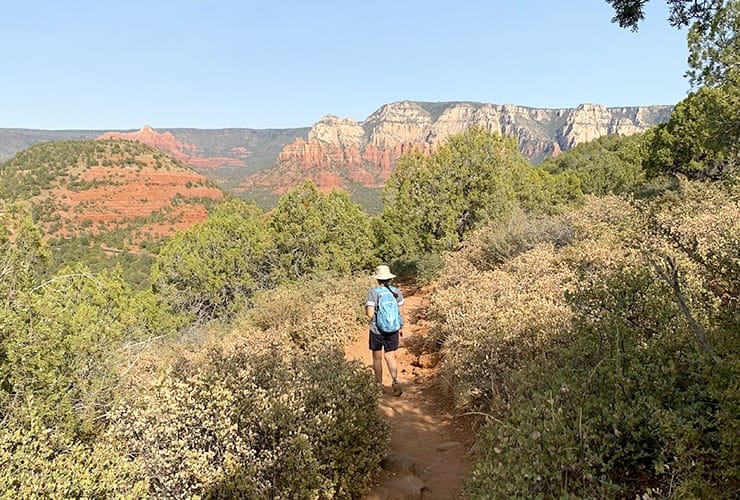
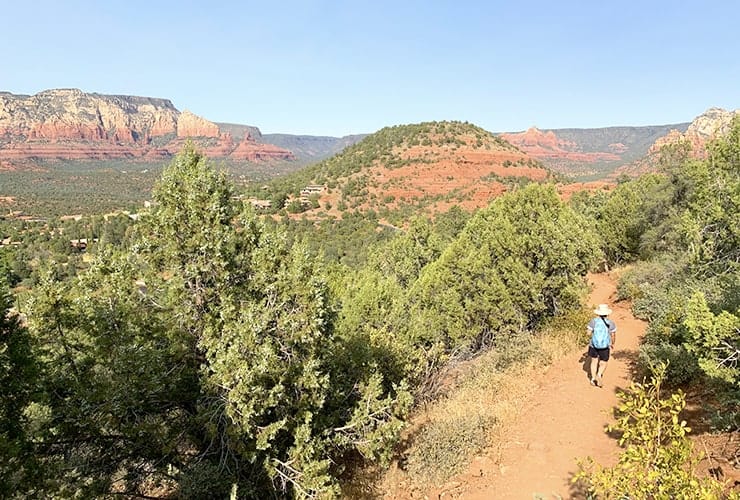
If you only had two words to describe the Airport Mesa Loop they would be awe-inspiring and rocky. The loop sits around 415’ (126.5 m) in elevation perfectly situated to provide amazing views of the mountains and valleys that encompass Sedona. The trail itself takes you entirely around the mesa so you get a birds eye view of all the places you can visit in Sedona. The best place to start is from the parking lot that sits at the top of the mesa. The first 20 minutes of the hike runs you parallel to the airport along the cliffside until you encounter an opening . . .
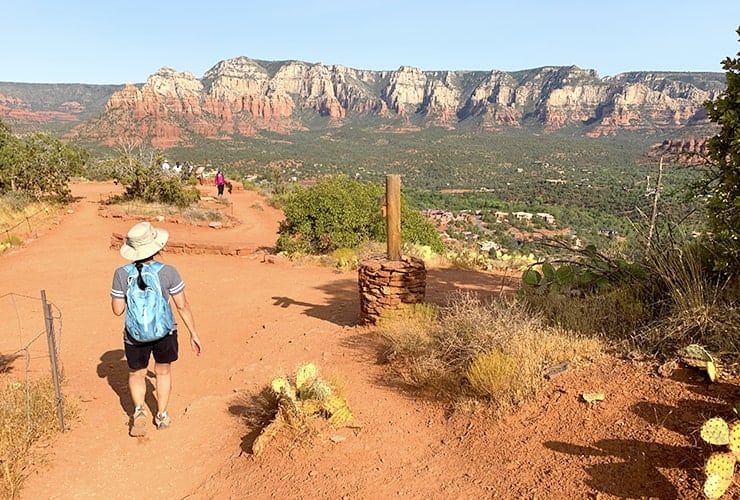
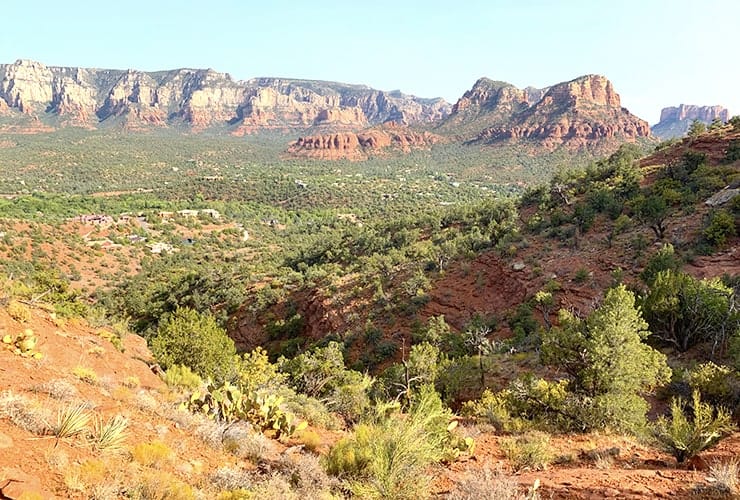
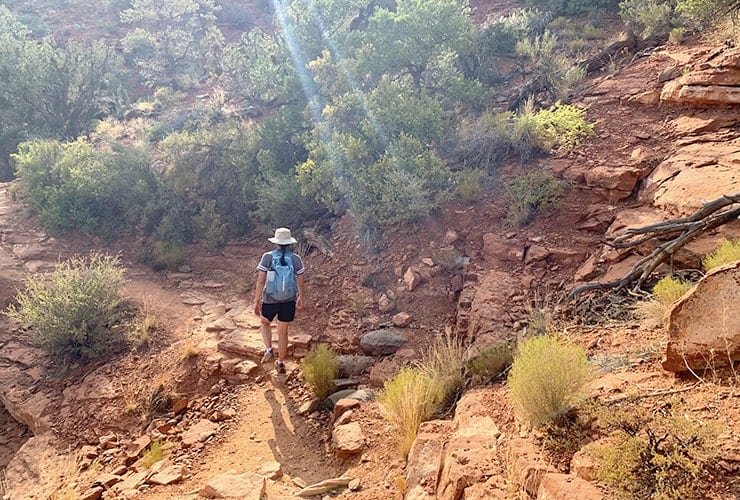
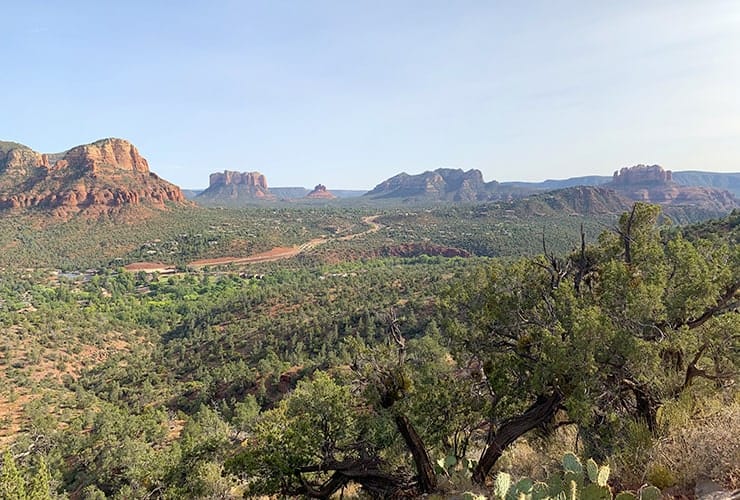
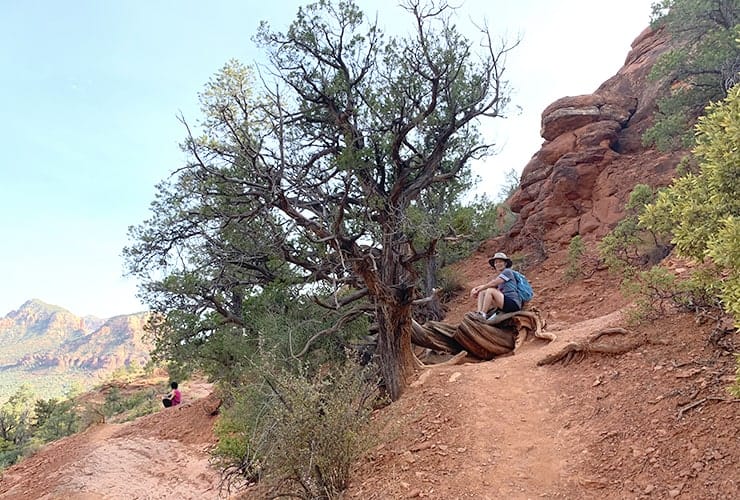
The opening brings you down just below the base of the Airport Mesa Saddle vortex (high above to your left) to a vista with views of indescribable beauty. Looking down you see AZ-179 wind its way through the Oak Creek Valley with views of Mitten Ridge, Merry Go Round, Snoopy Rock, a sliver of Submarine Rock, Battlement Mesa, the Twin Buttes, Cathedral Rock and Bell Rock with Munds and Lee Mountains painting the horizon. The trail is very rocky and this is where it really pays to have thick-soled hiking shoes to protect from some of the sharper rocks. It’s said that the vortex energies are strong around the twisted trunks and branches of Juniper and Manzanita trees, which can be found along the trail. If you look closely you’ll even see the western face of Chapel of the Holy Cross.
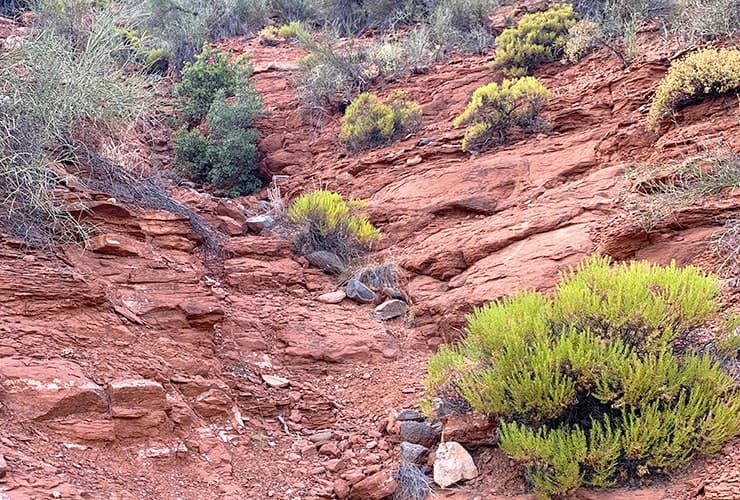
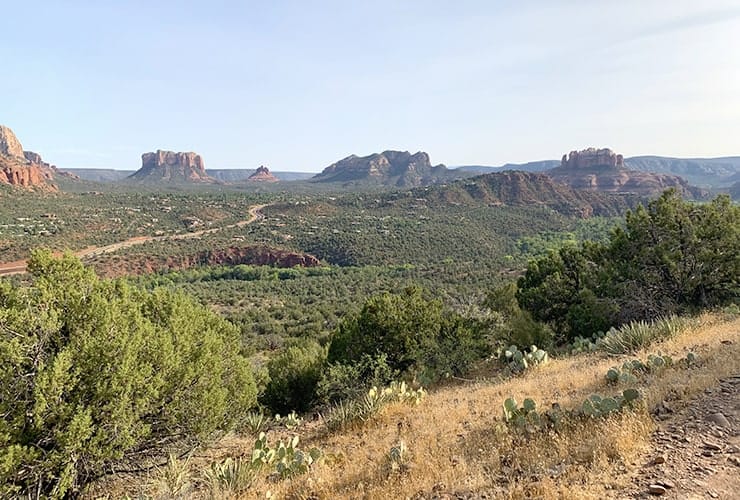
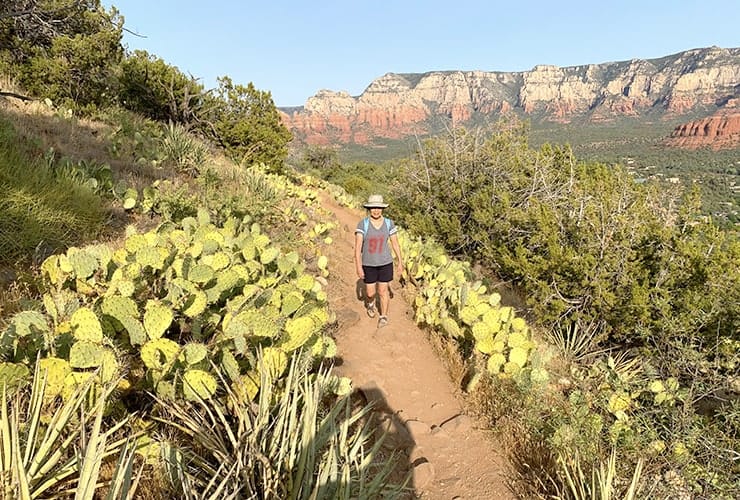
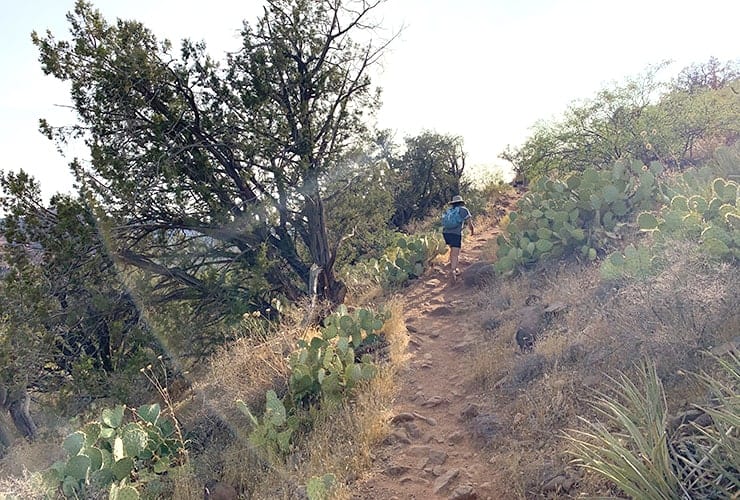
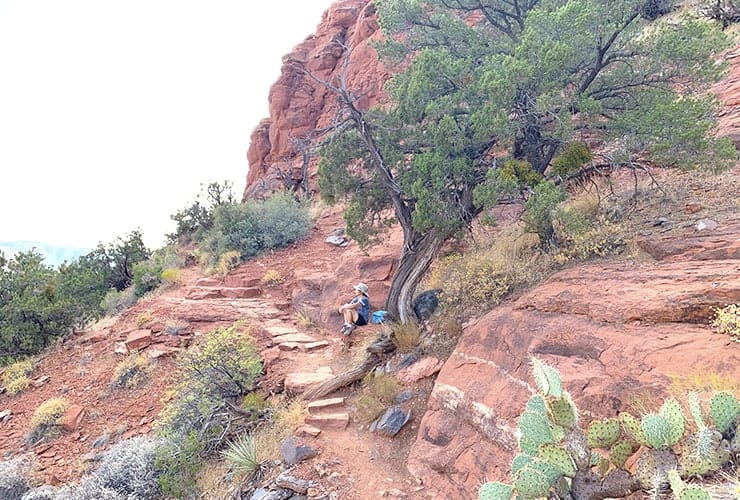
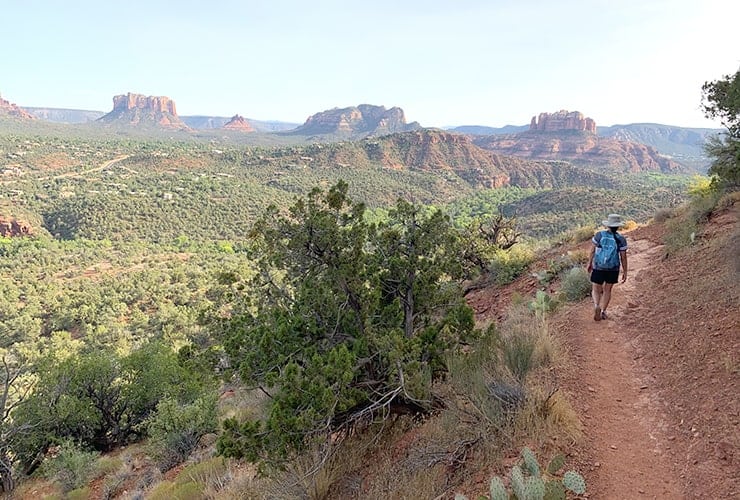
Keep an eye out for amazing layered red rock formations on your right as well as a variety of desert prickly pear cacti and various succulents like soaptree, yucca, century plant and tonto basin agave. As you proceed southwest around the rim you begin to see much clearer views of Courthouse Butte, Bell Rock and Cathedral Rock spread across the valley. The trail now starts to get rockier with steeper inclines but Tabletop Mountain provides shade and there are plenty of great stops for resting and water breaks. While the trails are safe please hike single file as the drop offs over the edges can be quite steep and treacherous.
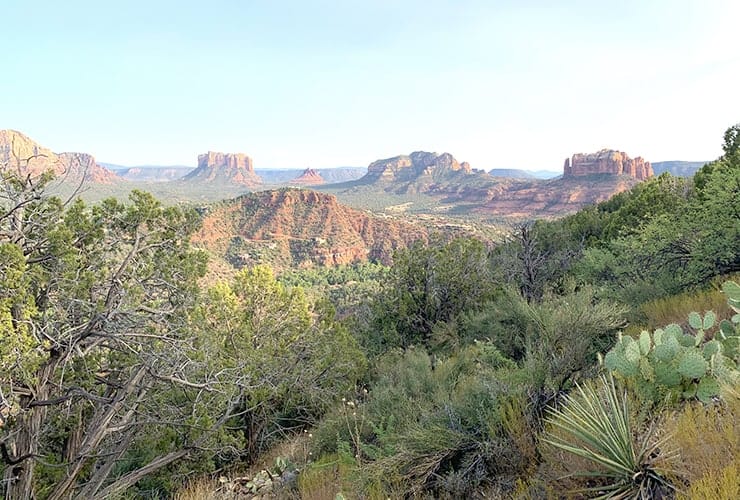
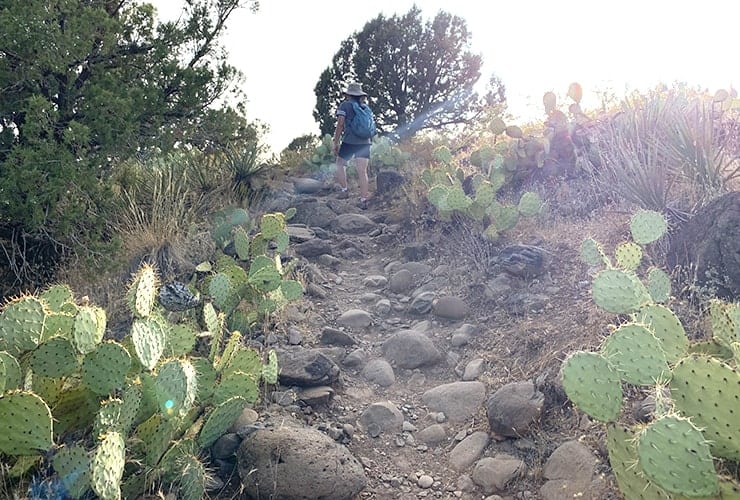
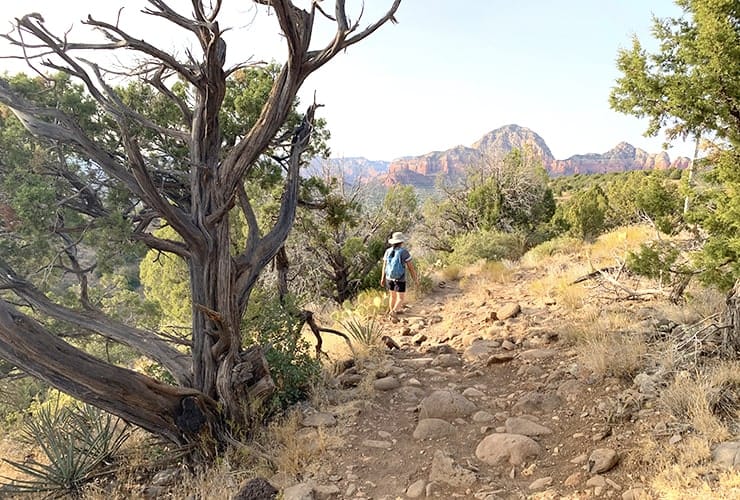
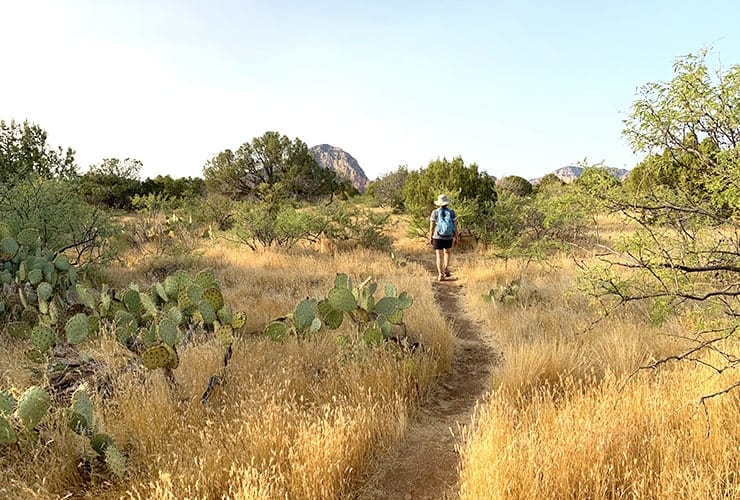
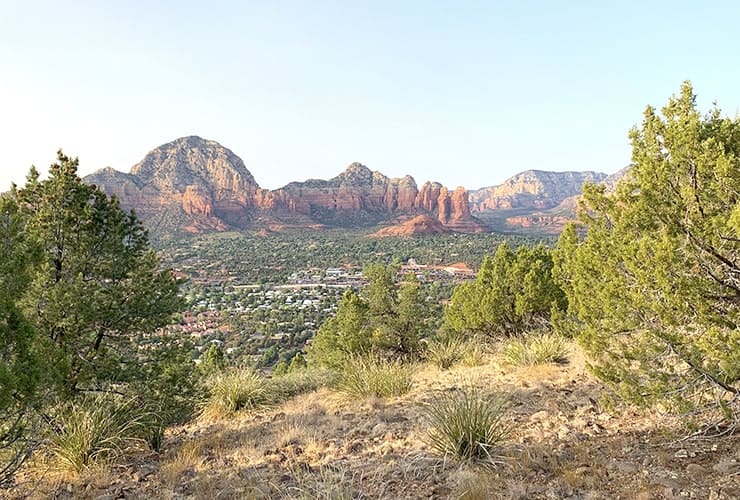
After one last steep cliff you reach a relatively flat area at the top of Tabletop Mountain with the outskirts of the airport to your right. The trail gets even rockier and the shade is gone. You begin to see West Sedona as the Capital Butte extends above the treeline. Eventually that view goes away and the next portion of the hike feels like you’re in a different country with lots of low shrubbery, small trees and cacti. Eventually you get on the northwest side of the mountain and continue around the rim until you get back to the lookout. The view from the northwest lookout is a postcard of West Sedona that includes Cockscomb, Boynton Canyon, Bear Mountain, Chimney Rock, Capital Butte, Sugarloaf, Coffee Pot Rock, Wilson Mountain and Schnebly Hill. We recommend you take on the 3.2 mile (5.15 km) hike mid-afternoon so you can time your finish at the lookout around sunset. You can also enjoy a stunning sunset from atop the vortex as well.
Soldiers Pass Trail

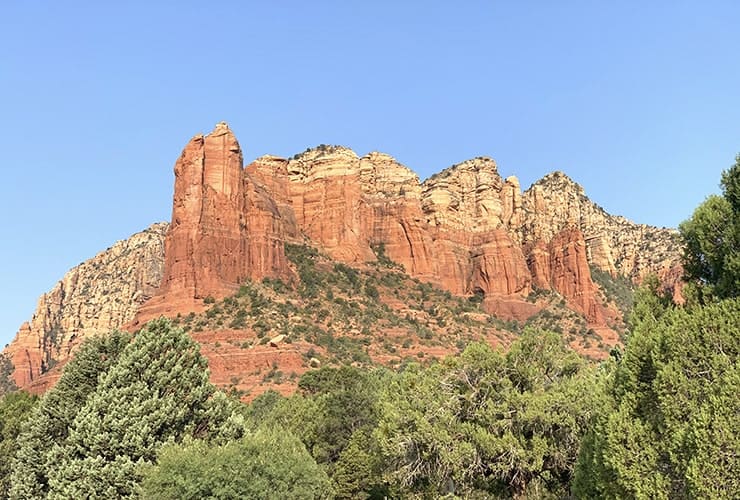
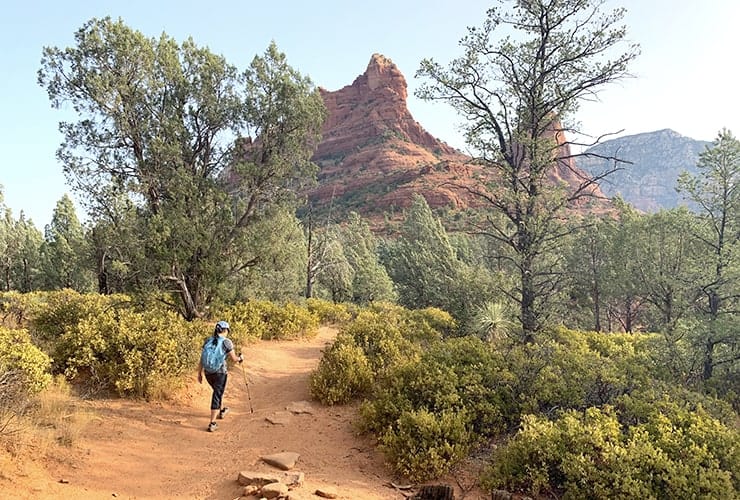
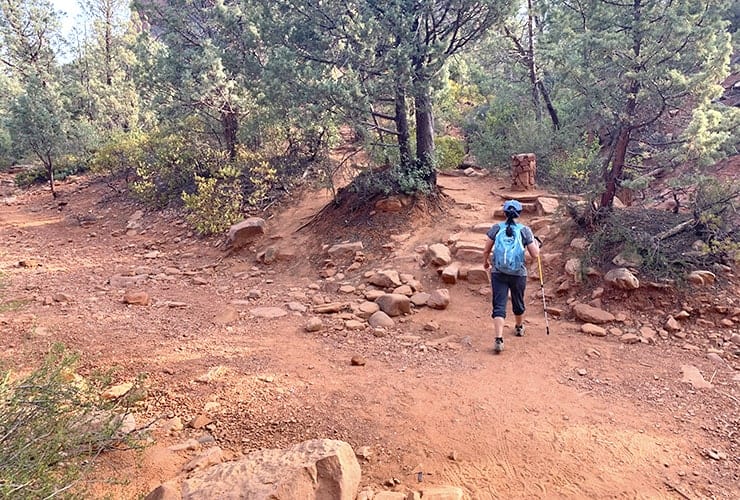
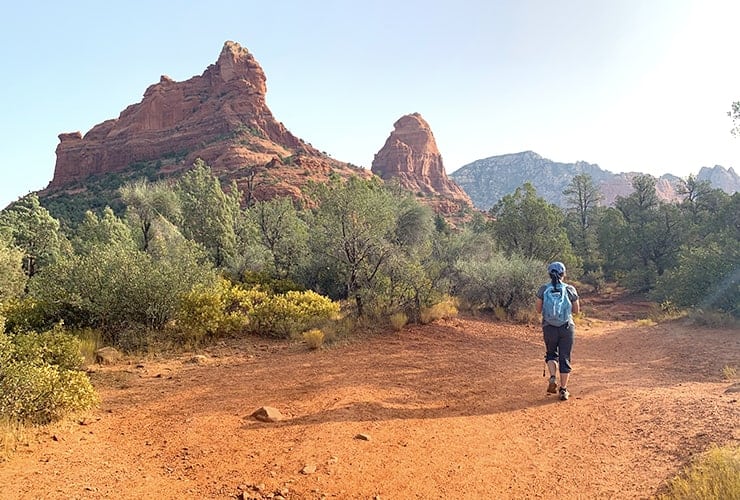
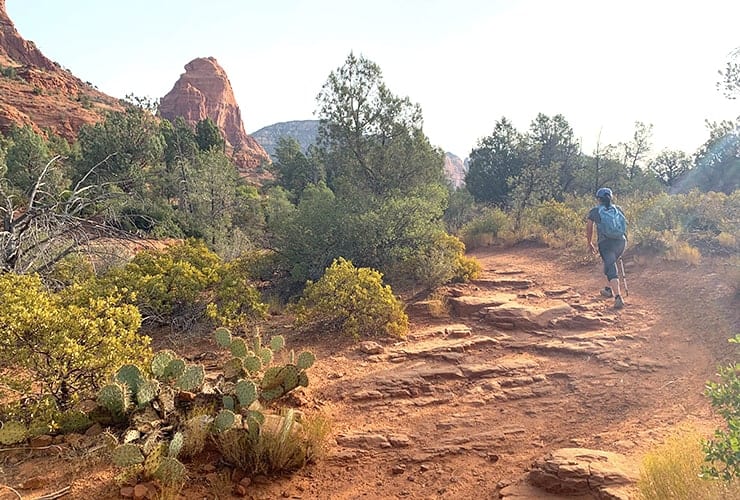
The Soldiers Pass Trail opens promptly at 8 am and it’s best to get there early as a car line forms and there are limited parking spaces available. From the parking lot you get an excellent view of Coffee Pot Rock but as you enter the trailhead the first thing that gets your attention is The Sphinx. The two towers rise up as the morning sun reflects off of their western cliff faces. You’ll cross over a large, dry riverbed, one of many we encountered while in Sedona. We learned that there had been only a single day of rain in the past year and yet there was an astonishing amount of greenery and succulents still thriving. You continue climbing for about 10 minutes until you reach one of Sedona’s more unique attractions . . .
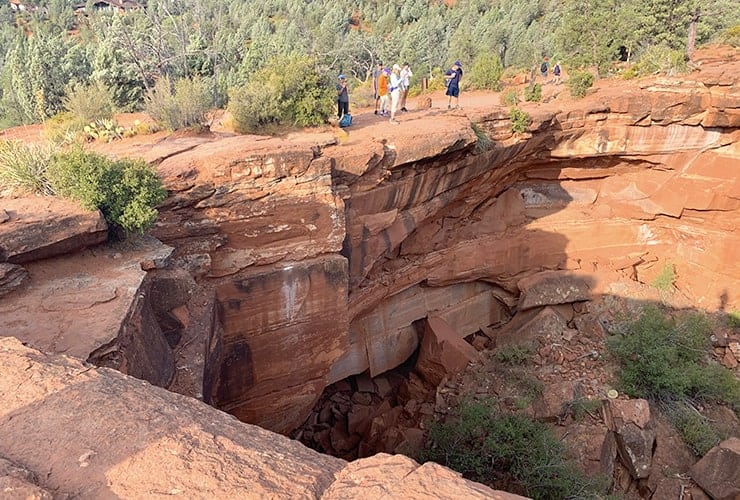
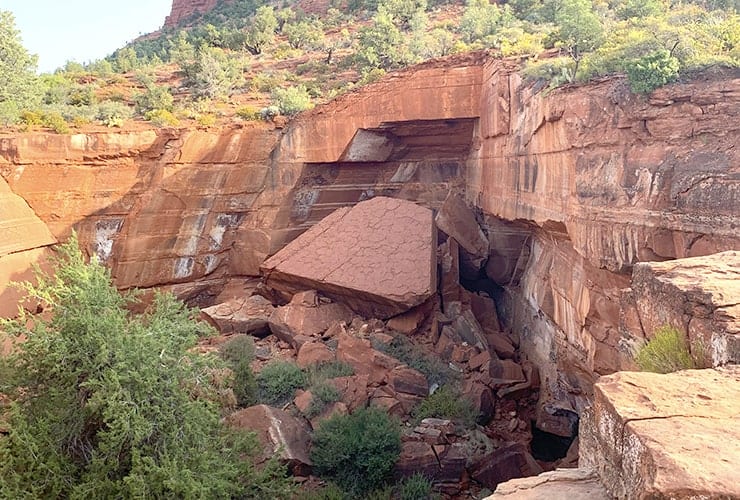
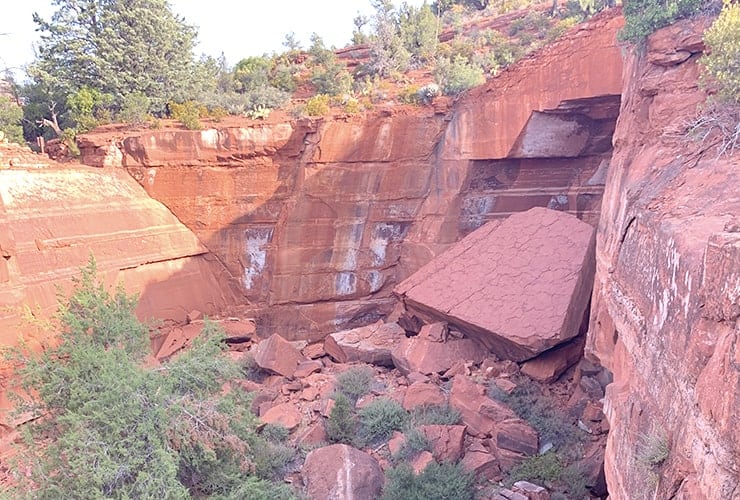
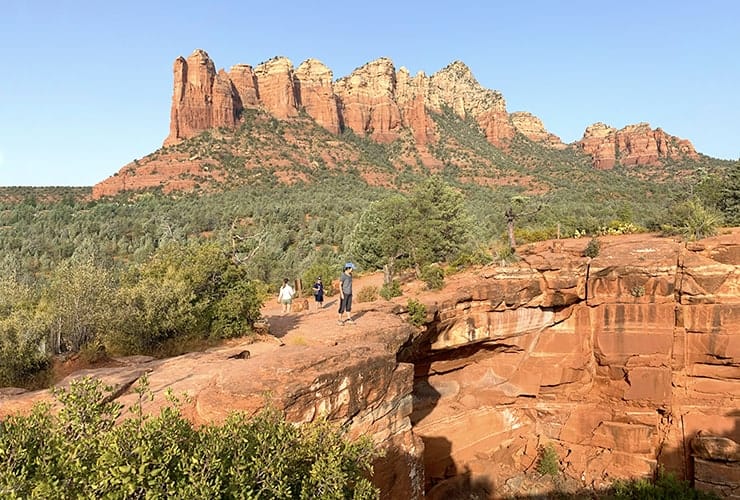
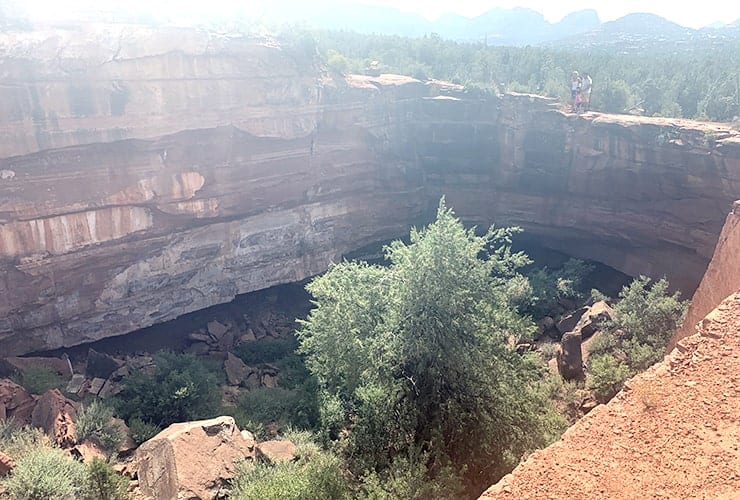
The Devil’s Sinkhole was created by the ceiling collapse of a massive underground cavern, around 600’ (182.9 m) below the surface, sometime in the 1880’s. It has since had at least two other collapses since then and the sinkhole is today around 150’ (45.7 m) in width and 50’ (15.2 m) in depth. You can walk around most of the Devil’s Kitchen (except above it) to get different perspectives and marvel at the rock fissures caused by the collapse but also the trees growing along the bottom. It is predicted that the sinkhole will continue to expand, likely in width but not necessarily in depth.
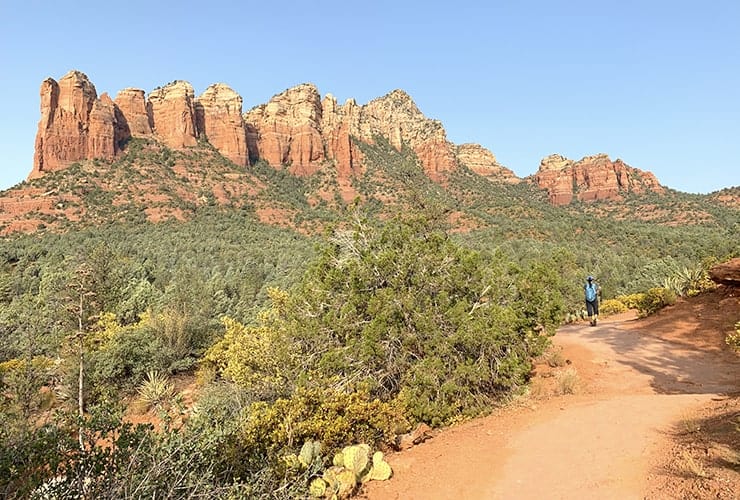
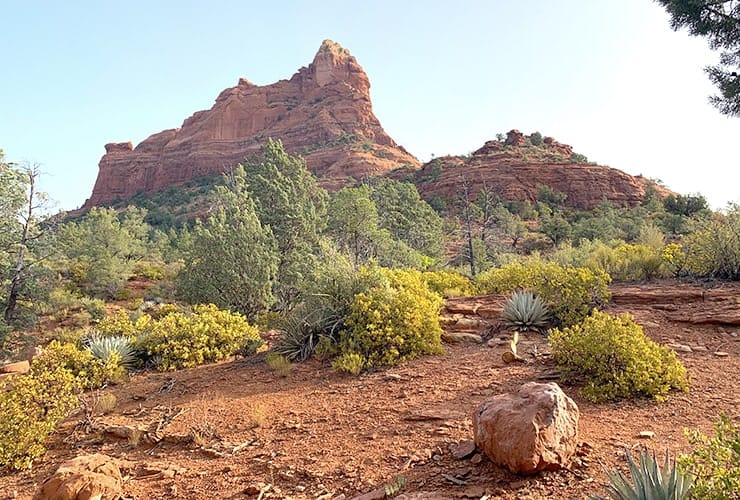
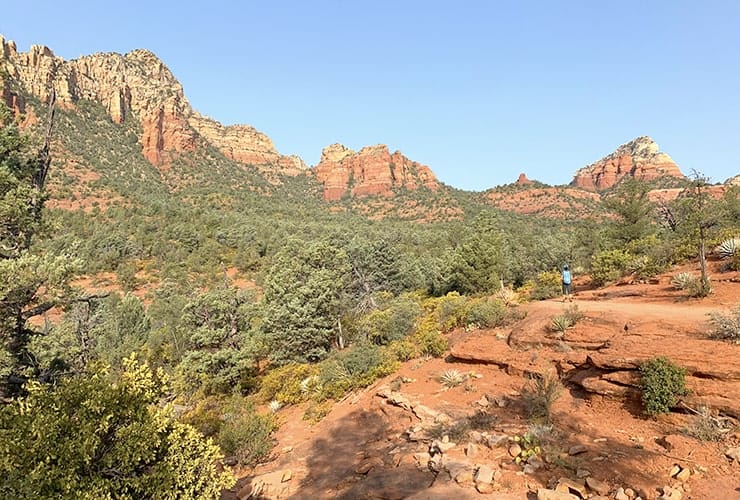
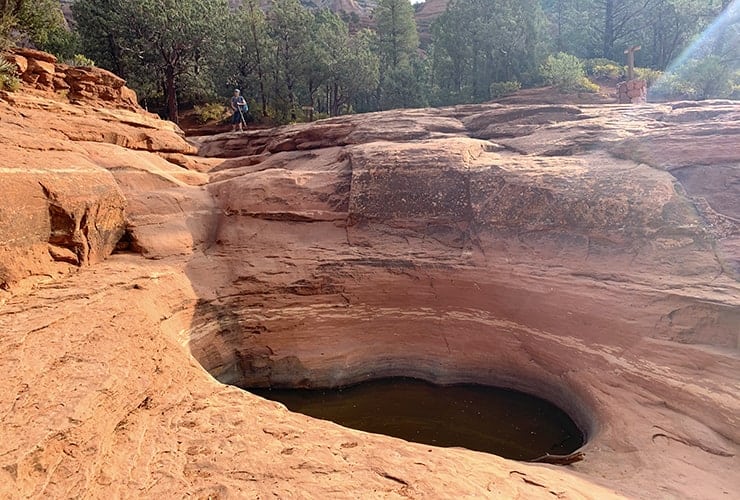
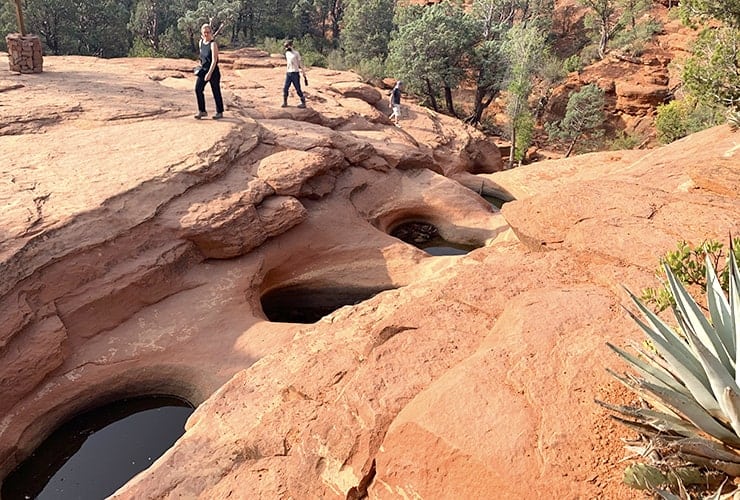
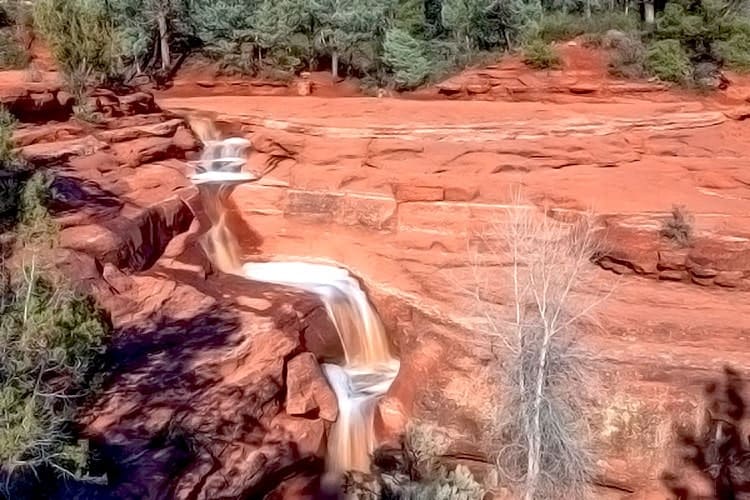
As you continue on, the Soldiers Arch rises high to the west reflecting the morning sun. The hiking path is smooth rock and dirt with a steady covering of red dust that mats your socks and lower legs. The top portion of the Sphinx is no longer in the light but much of the basin and lower sections still are as you walk in-and-out of Arizona cypress forests and across the rims of small canyons. About a quarter mile on you encounter the 7 Sacred Pools, considered sacred ground by the Apache and Yavapai people. Because of the lack of rainfall the pools weren’t as dramatic as they usually are but it is still an amazing natural phenomenon. During the wet season the pools each feed the next in a series of cascading waterfalls.
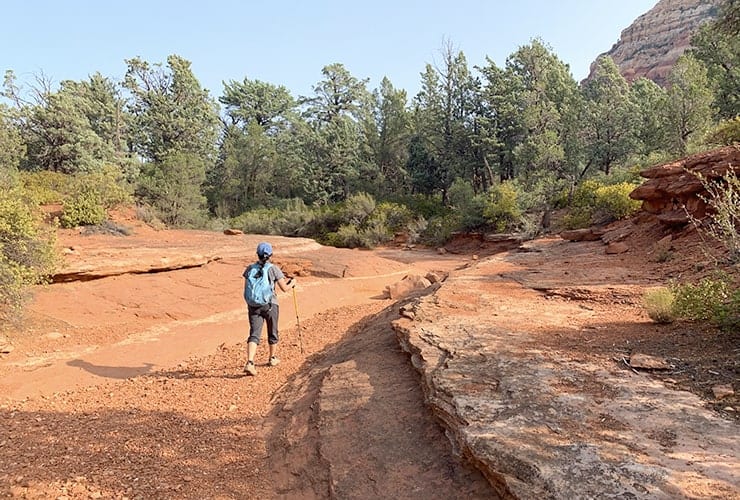
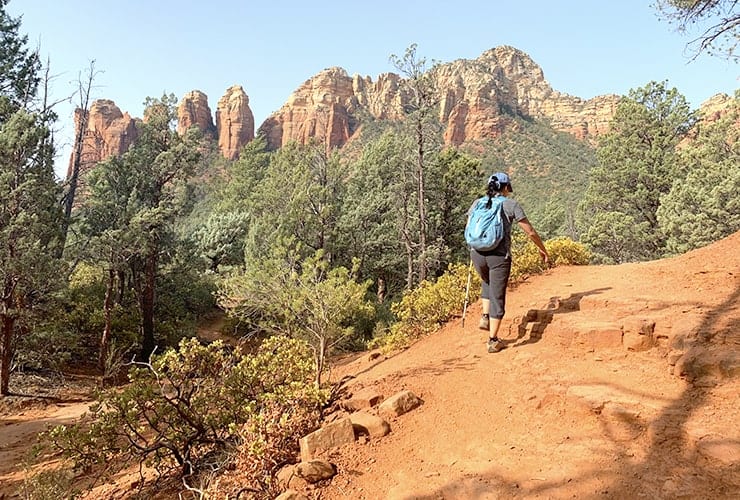
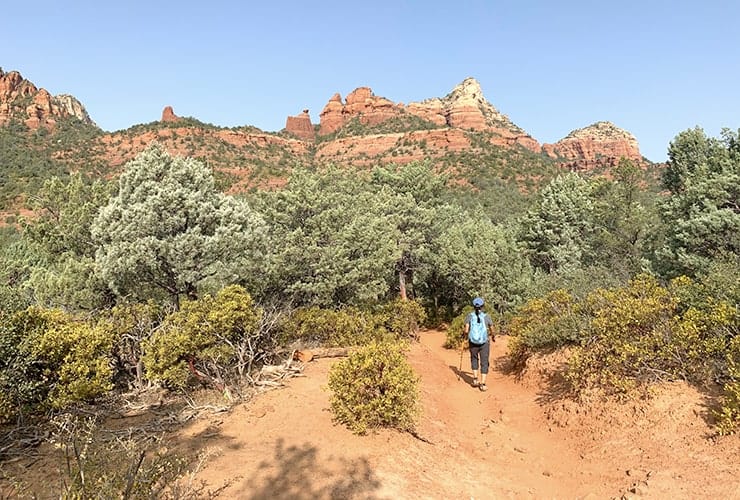
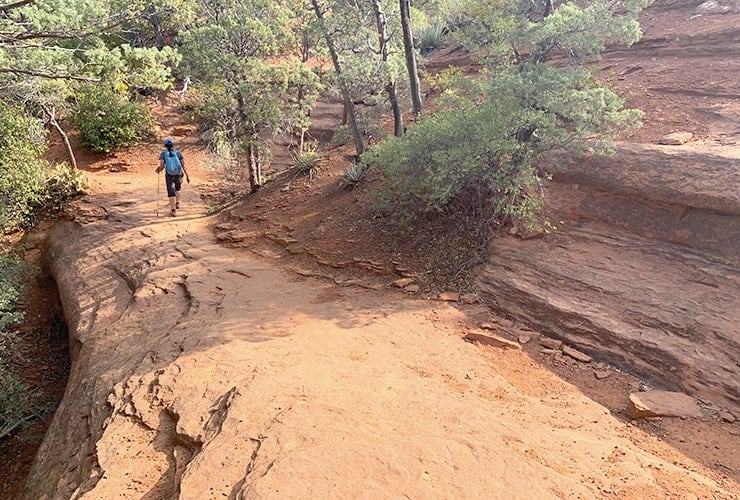
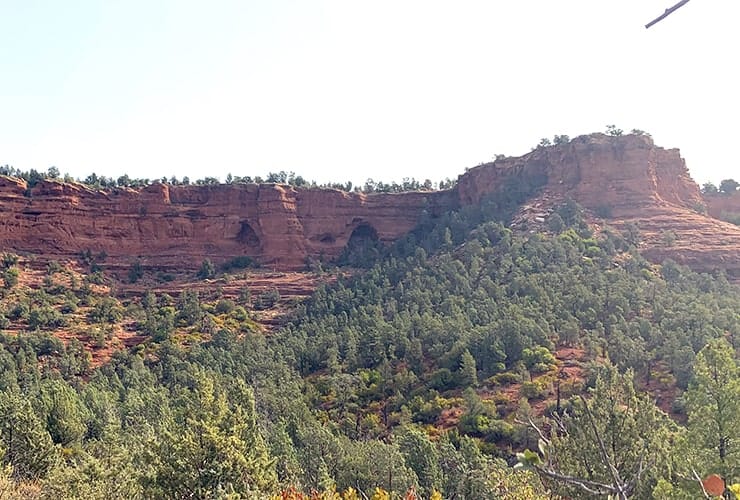
As you leave the pools be sure to follow the signs . . . we didn’t. We followed the creek bed that normally feeds the pools and discovered a wonderful rock shelf formation that serve as embankments to stem the water flow. When it became clear we messed up we were easily able to backtrack and continue north on the Soldiers Pass Trail. With the two main attractions behind us we were able to enjoy all of the natural beauty around us. To the east is The Mitten and Brin’s Ridge with its amazing wind-worn cave openings high along the rim. To the north are several distinctive ridges and spires that cover much of the geological chart including Coconino Sandstone, Schnebly Hill Sandstone, Ft. Apache Sandstone plus Hermit Foundation and Supai Group.
This was one of the busier trails, particularly up until the 7 Sacred pools, but everyone was friendly and accommodating . . . as always seems to be the case with hikers.
Boynton Canyon Trail

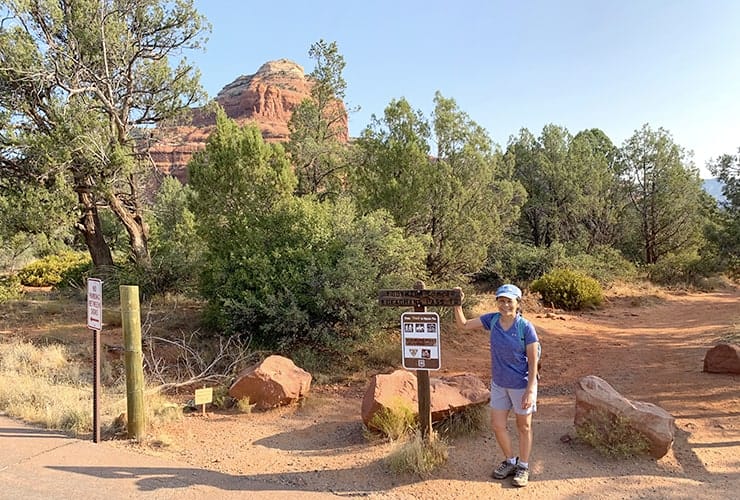
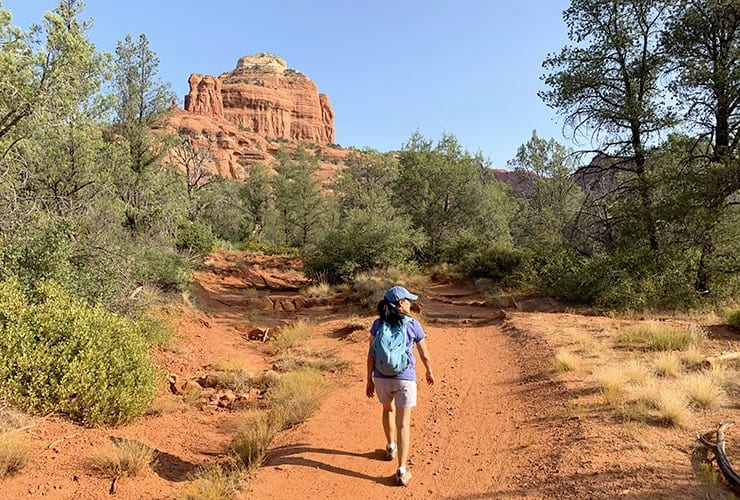
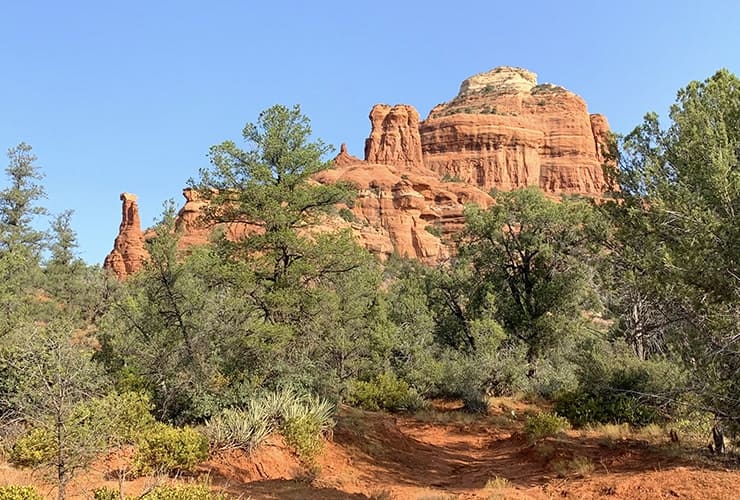
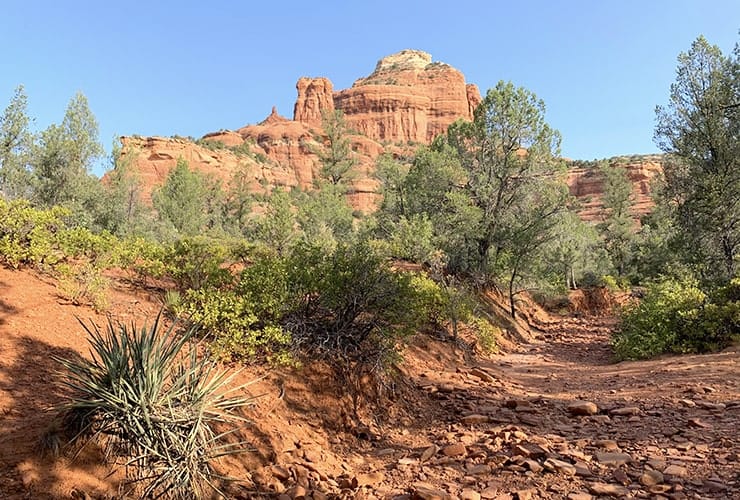
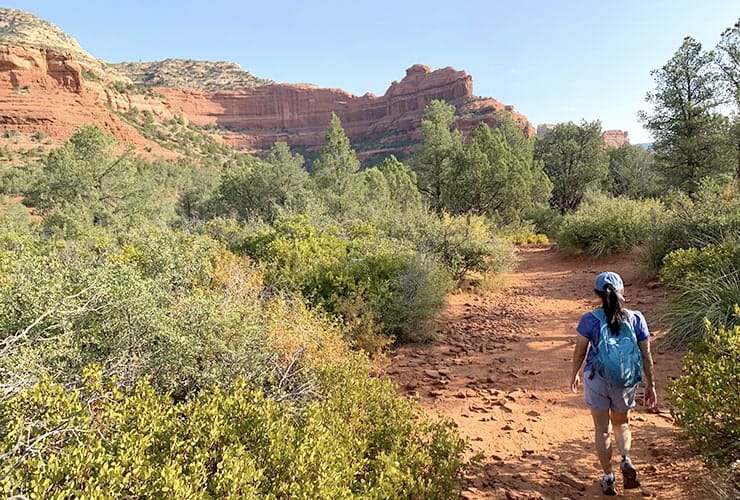
Our Boynton Canyon experience was highly enjoyable . . . we got wonderfully lost a few times, met two locals who were full of great stories and recommendations and, finally, experienced our favorite vortex. Our intention was to just walk Deadman’s Pass and then visit the Boynton Canyon vortex. The trail starts off nice and flat with a fair amount of shade and fantastic red rock views to the north including Kachina Woman. You pass a wide dry riverbed filled with red rocks of various sizes and shapes. Everything was fine until we turned southeast on a “trail” that turned out to be the Mescal Trail.
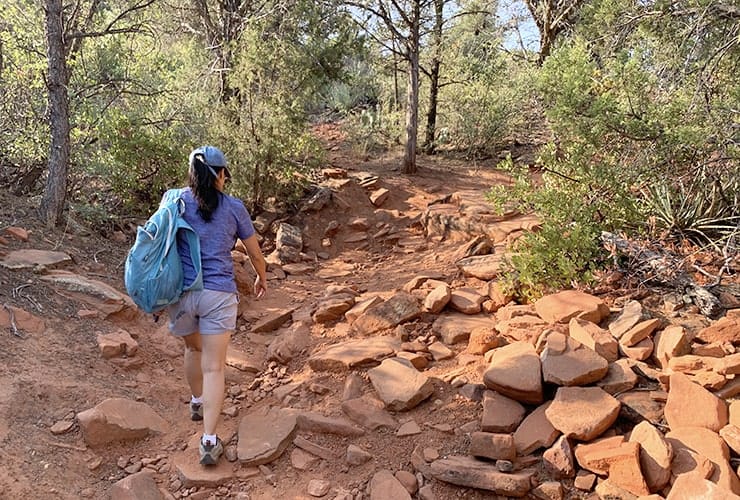
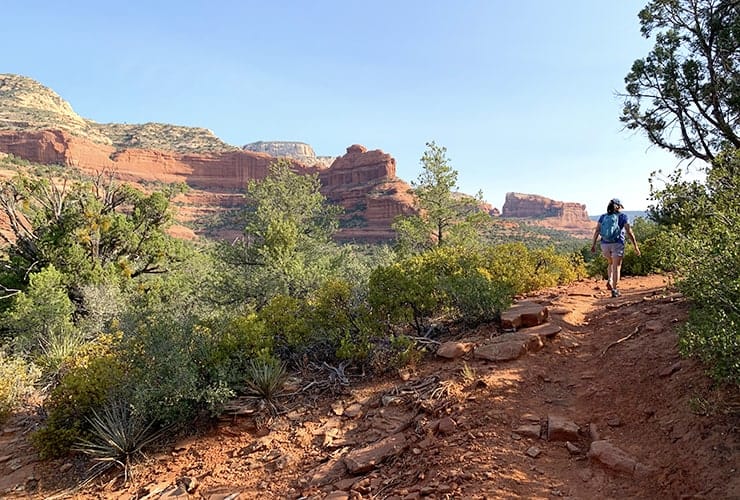
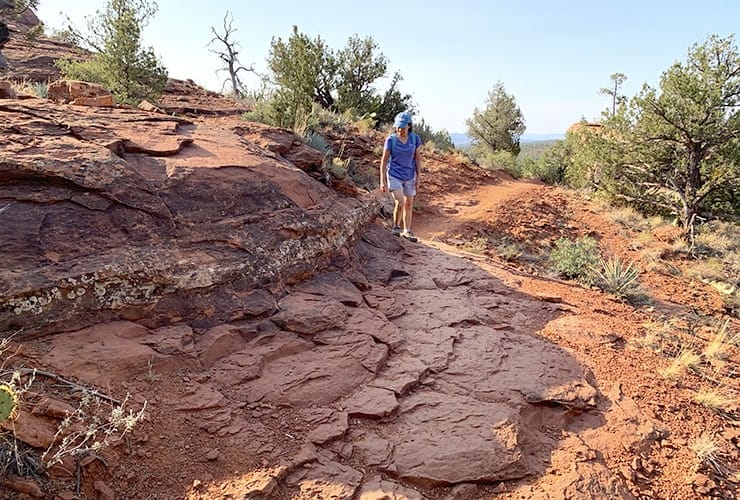
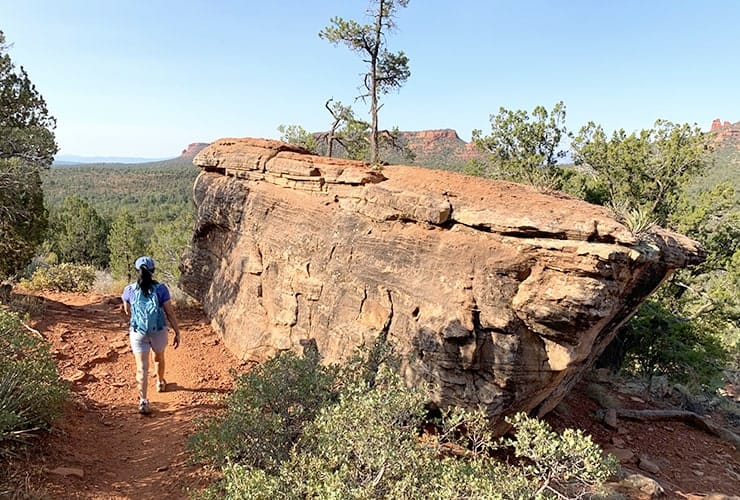
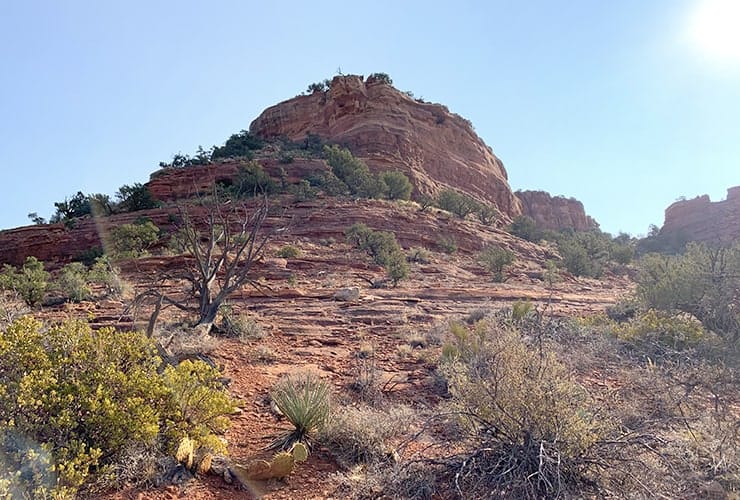
The Mescal Trail veers southeast and up along red rock paths framed by twisted Juniper trees, manzanita bushes and Prickly Pear cactus. The trail is covered with red rock dust and some sections are quite rocky but overall it’s an easy hike. As you ascend you can turn around to get fantastic views of the morning sun reflecting off the red rock formations that enclose the distant Boynton Canyon. You also get a nice elevated view of the Kachina Woman and Warrior Man. At some point you begin to circle the lower rim around Mescal Mountain. The layered rock formations are beautiful as well as a single large boulder to the right of the trail that is, similar to North Carolina’s Chimney Rock, home for a few small trees.
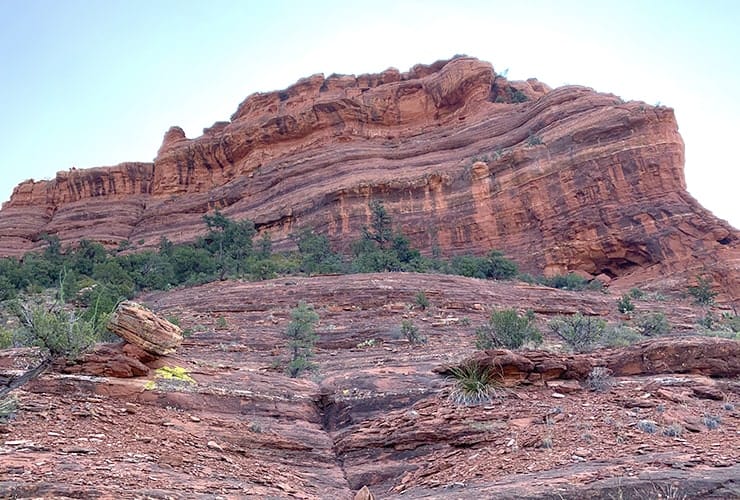
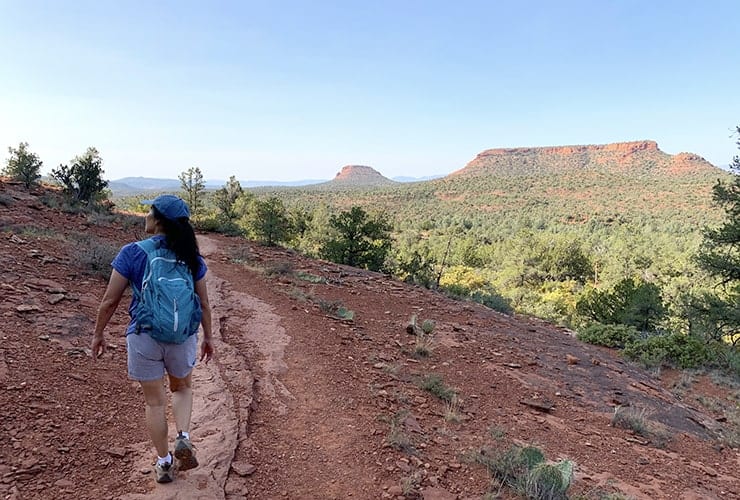
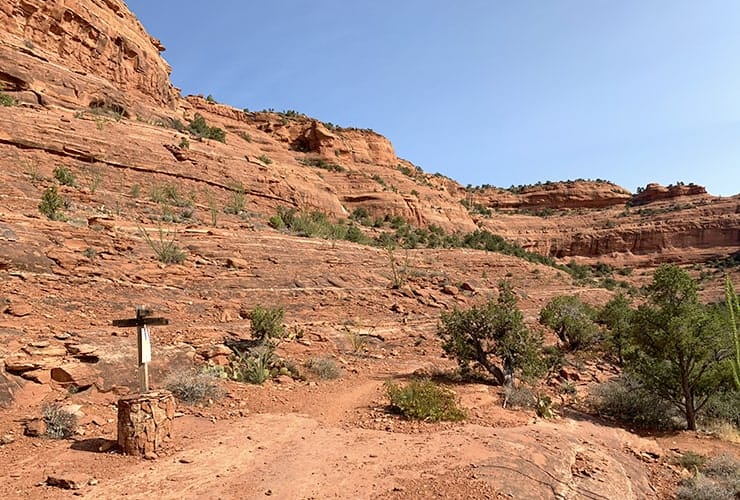
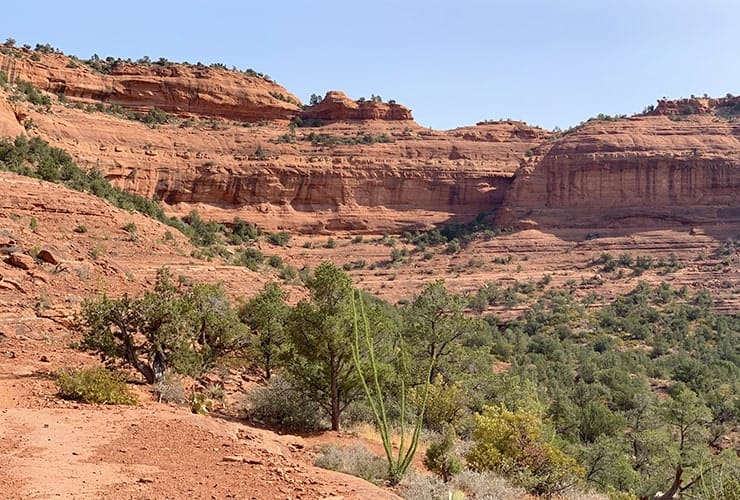
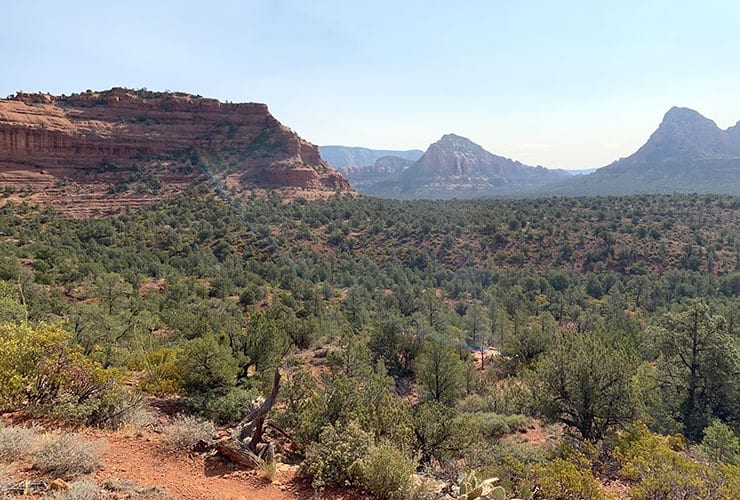
While the northside of Mescal Mountain is in the shade it is still imposing with its various layers, wind-worn cave openings and water stains. To the east you see a few buttes rising up from the Long and Fay Canyons. As you start to round the corner you notice the southeast side of Capital Butte, Thunder Mountain, parts of Mitten Ridge and Courthouse Butte. Further on you see the Canyon of Fools and an amazing panoramic view of Secret Mountain Wilderness. Even more impressive are the massive bowl shaped walls of Mescal Mountain. You could spend a few days just exploring this area alone. Around here is where we were pretty certain we took a wrong turn somewhere so we began to backtrack ourselves.
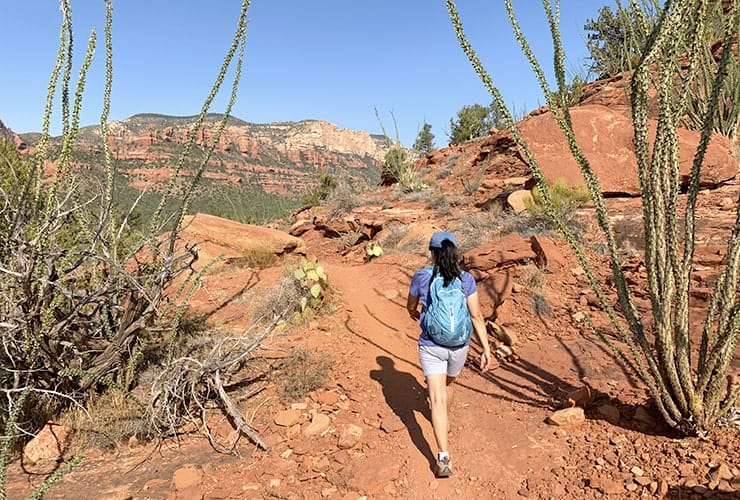
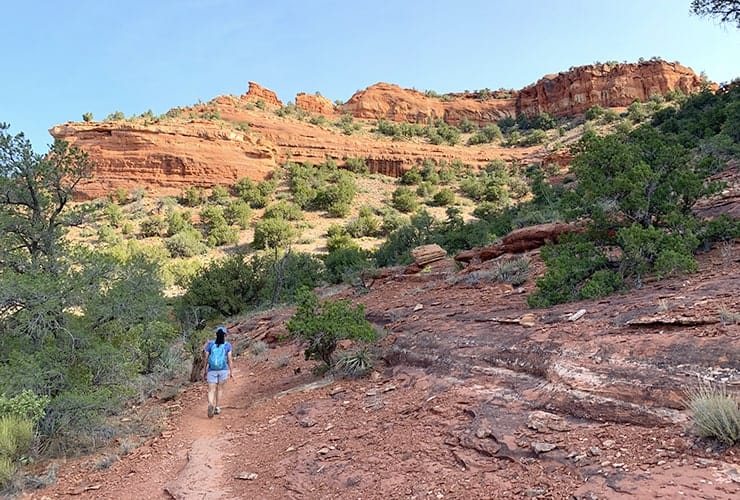
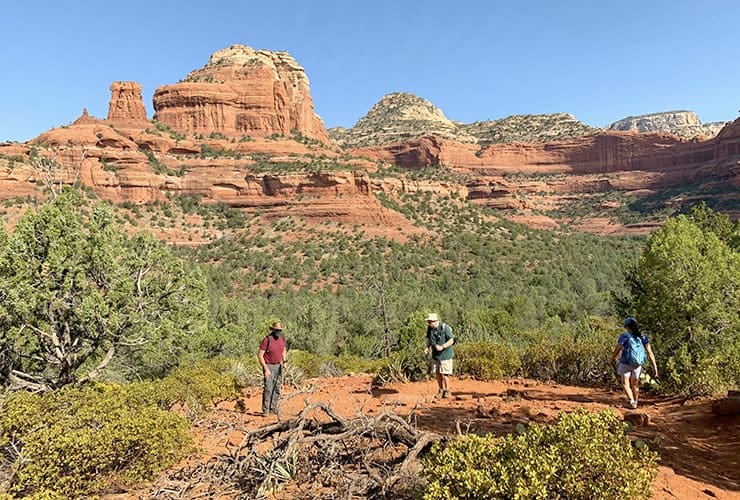
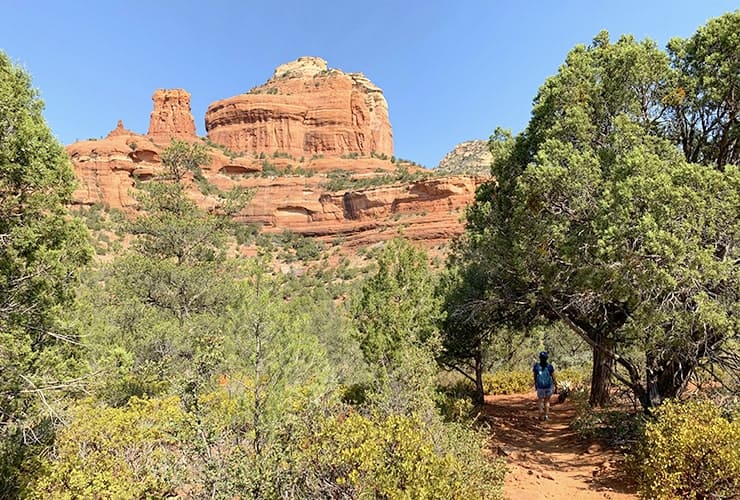
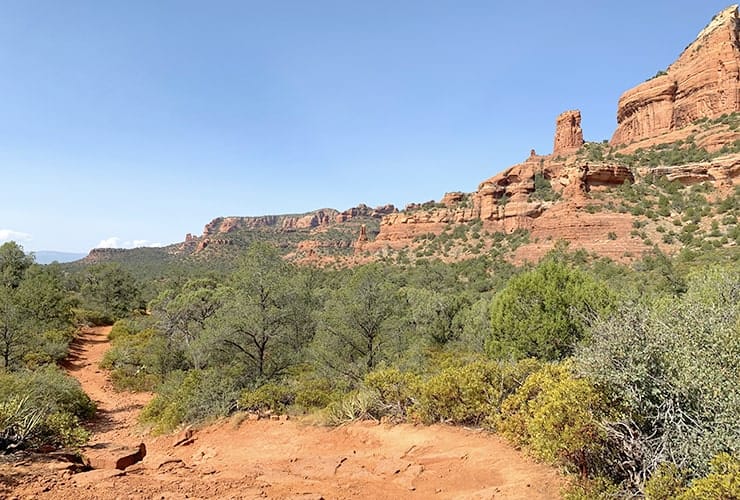
The journey back was fascinating in that it looked entirely different when in the direct sunlight. We saw a group of Desert Prickly Pear cacti framed by a group of rising Octillo plants. Some of the northside of Mescal Mountain was now in the sun and shining a bright orange hue that contrasted nicely with the sunlit and shaded Arizona Ash trees. By this time the rocks surrounding Boynton Canyon were well it and almost shining. We also had the pleasure of meeting a pair of older gentlemen who, it turns out, were locals that were more than happy to share their thoughts on the best places in Sedona to visit and hike. We finally connected with Deadman’s Pass trail and walked about a mile till it met up with Long Canyon Trail then turned back around.
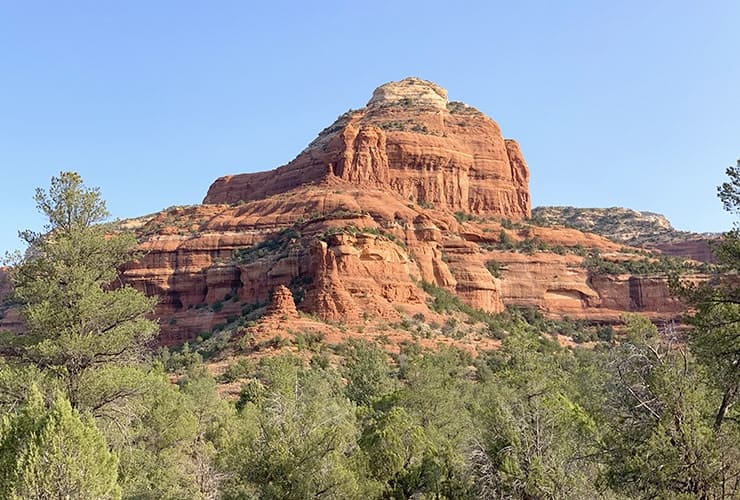
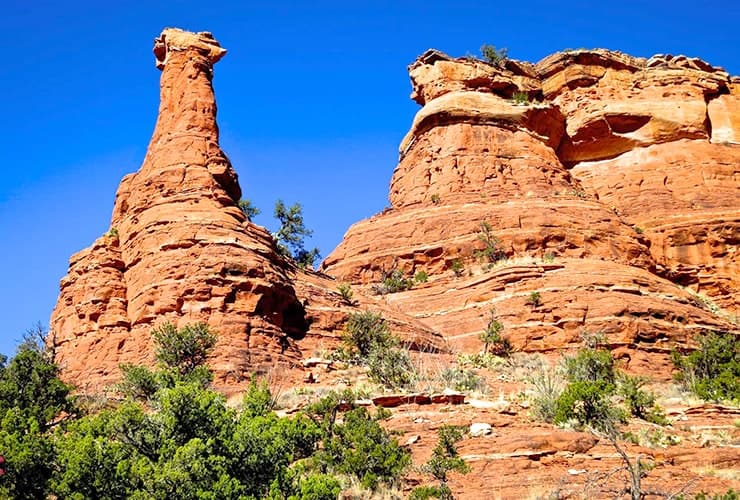
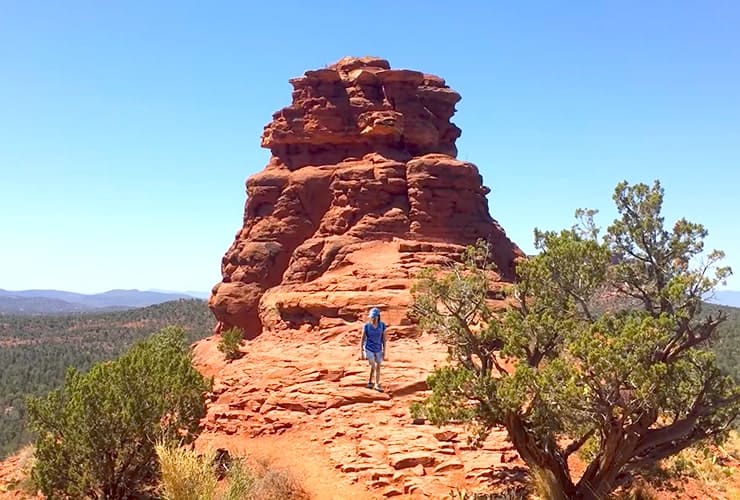
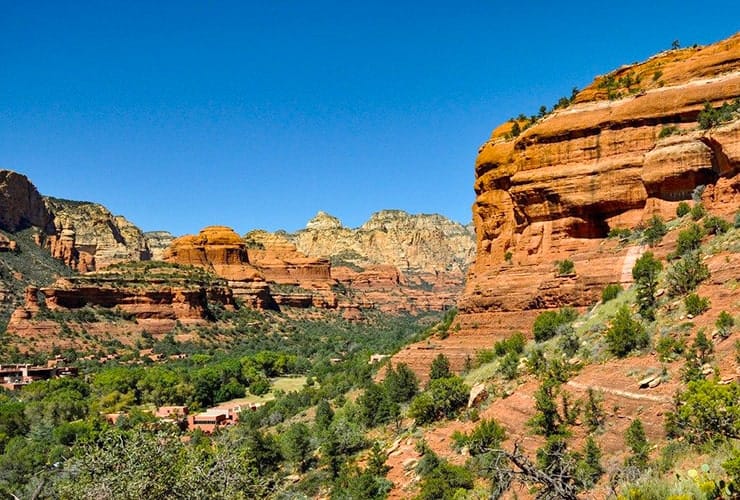
The last part of our hike required us to backtrack to pick up the Boynton Canyon Trailhead on our way to the vortex. As you head northwest you see a sign for “Vista” that dead-ins at the vortex site. In addition to any energy you might feel you are also treated to magnificent views including the southwest edge of Mescal Mountain (where we had been just a short while before). Looking to the northwest you see Boynton Canyon in all of its glory. There is also Warrior Man, which is a very popular spot for pictures that is occasionally home for Robert and his magical flute (so they say).
Devil’s Bridge Trail

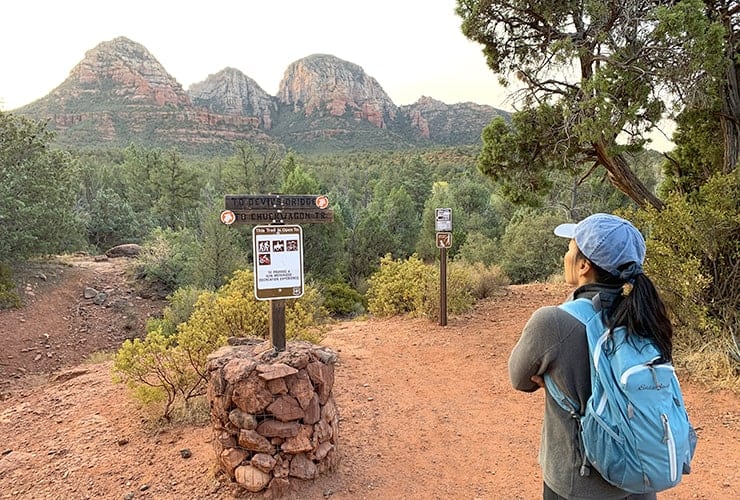
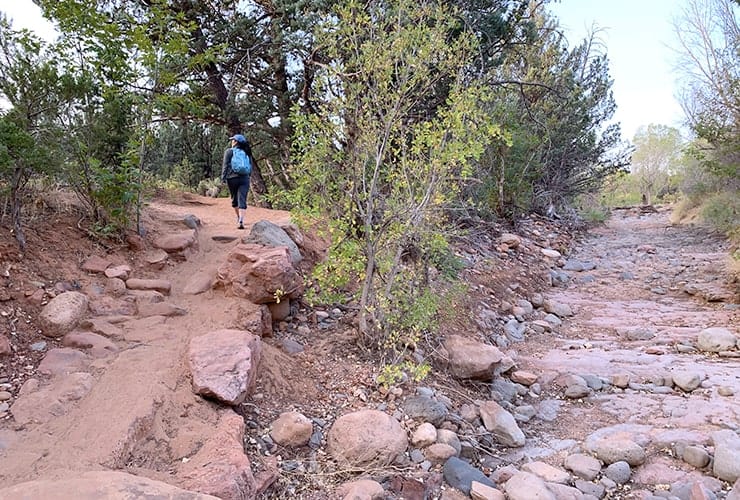
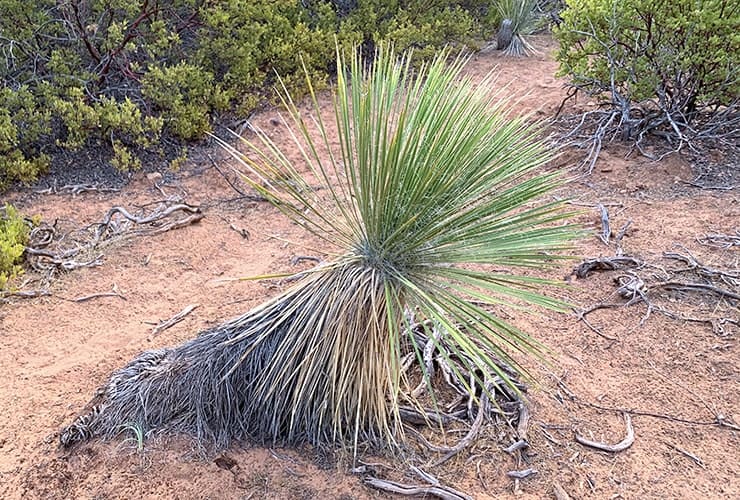
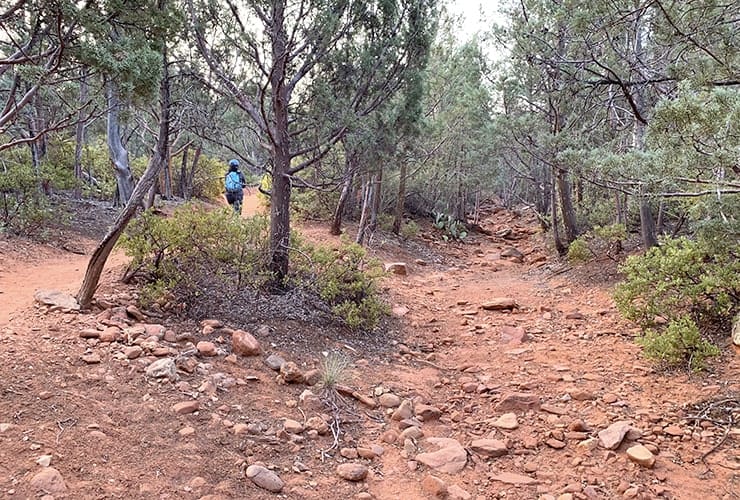
Saving the best for last . . . they say it’s not the destination but the journey that matters . . . what if you can have both? The Devil’s Bridge Trail is a magnificent blend of cactus flowers, tall desert agaves, foothill yuccas, manzanita bushes, banana yuccas, Juniper and Manzanita trees, sprawling valleys and monumental canyon walls. There are a few magnificent dry creek beds that would produce wonderful rapids with just a few inches of water flow. This trail is almost impossible to get lost on as the signage is excellent and, it is so popular you are guaranteed to find someone to ask should you feel lost.
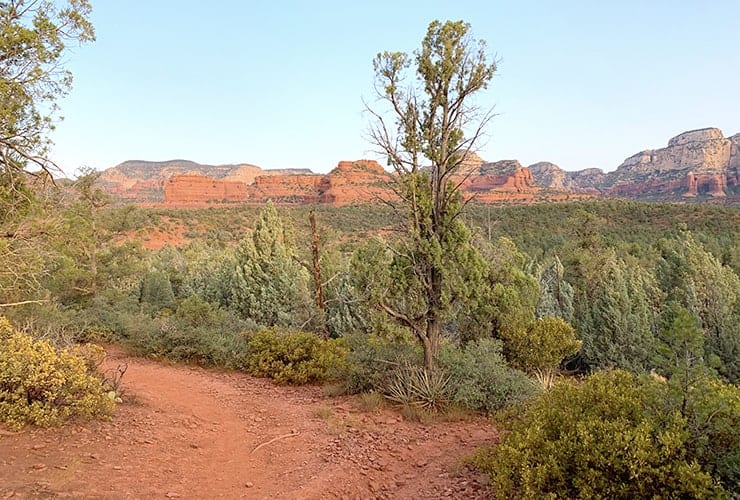
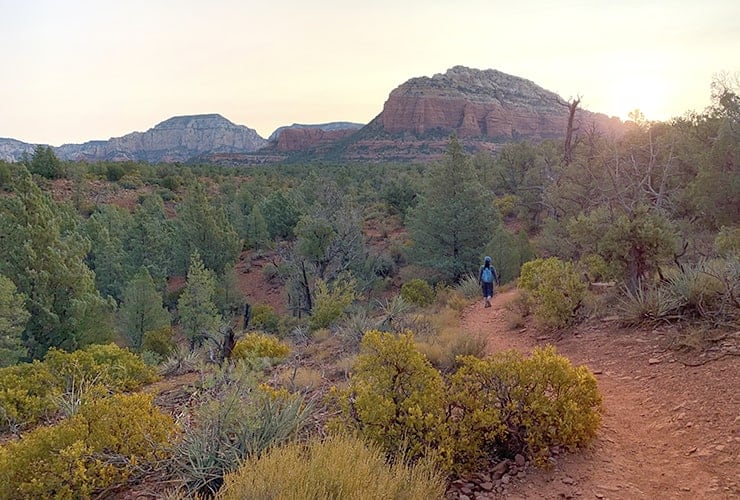
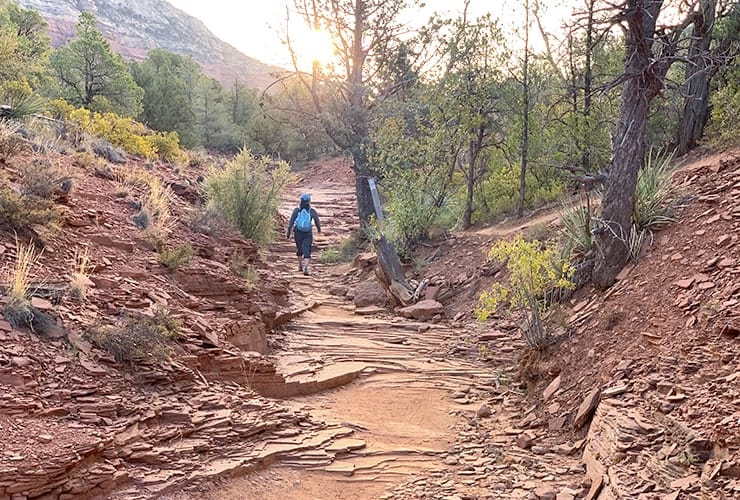
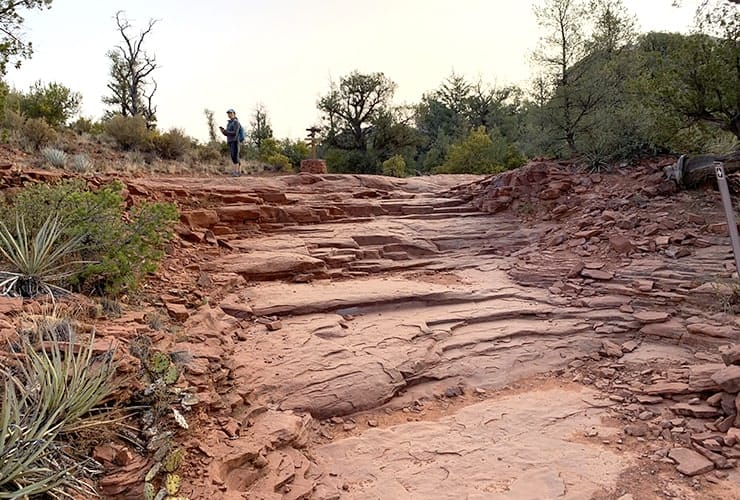
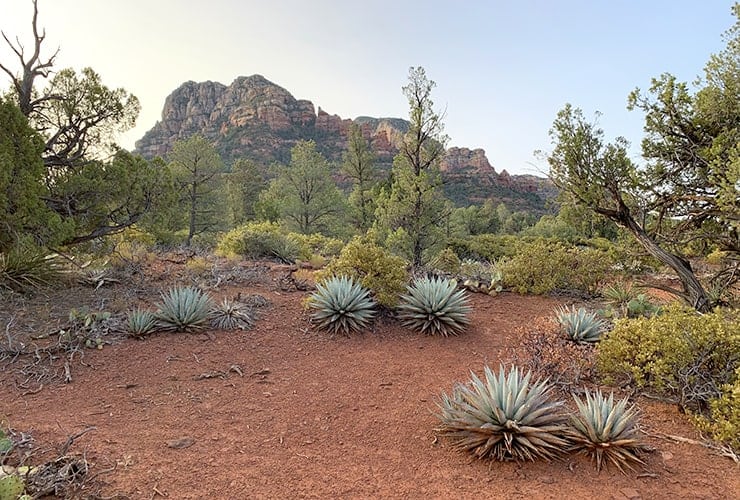
The morning sun positively glows off the Mescal Mountain to the west as you zig-zag your way to Thunder Mountain. A cool part of the trail was an old dry river bed about 10’ (3 m) in width whose striated layers serve as inclined steps that run right through the middle of the two towering monoliths directly ahead. Soon after the bed you come upon a flat opening that provides an amazing vista of Mescal and Bear Mountains and Boynton and Fay Canyons. Along the way you marvel at how there could be so much green in such a desolate and dry climate. There was one patch of agave plants, known locally as “cowboy killers” due to their rock hard stems and razor-sharp thorns, that provided a nice contrast with the surrounding red rocks and dust.
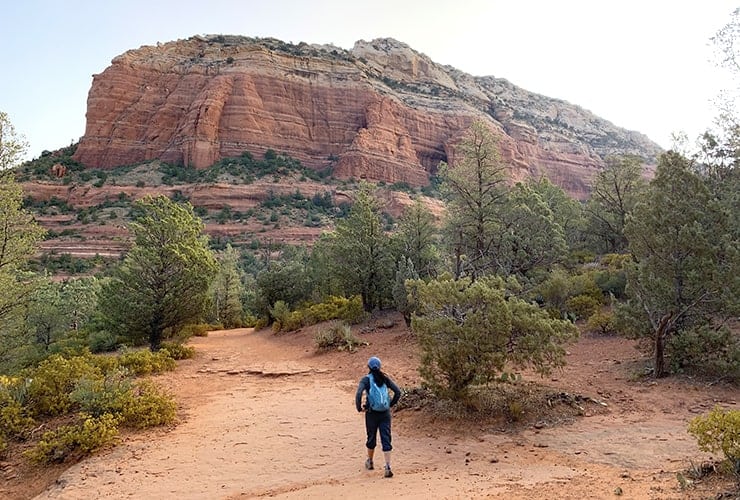
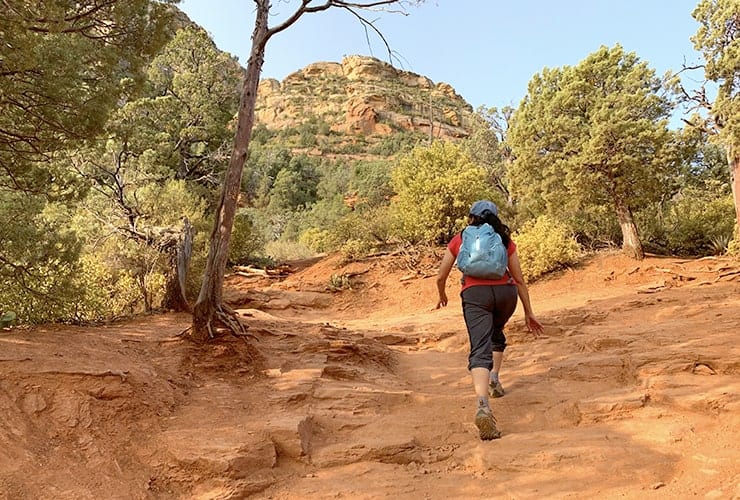
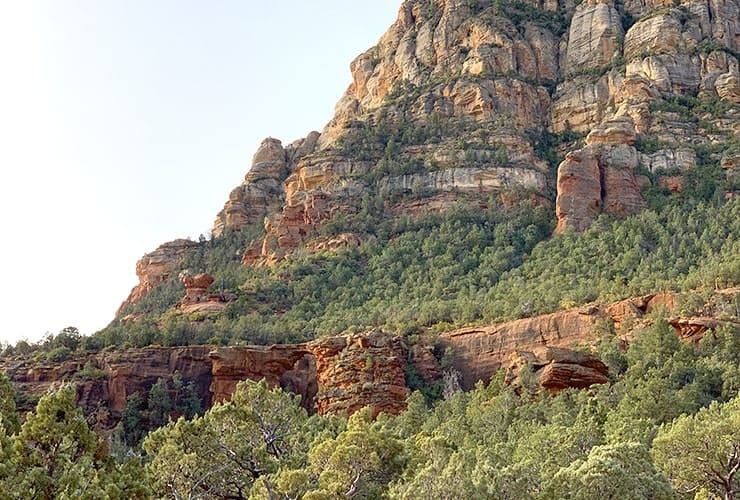
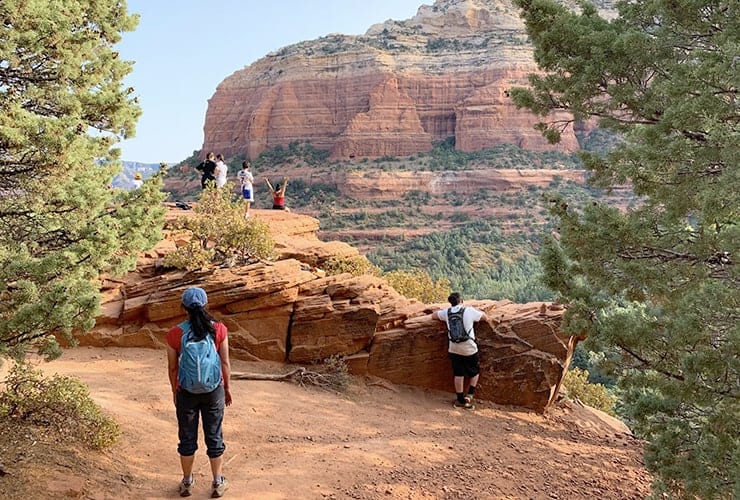
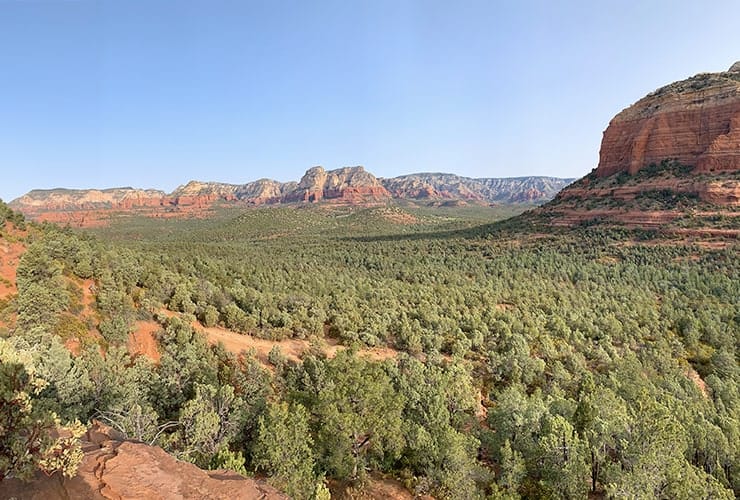
Soon you reach a crossroads where the hiking path overlaps with the 4X4 road. Continue straight along a wide red rock dust path, bearing left at the fork, appreciating the beautiful red rock mountain to the east and Thunder mountain to the west. You begin a slow red rock ascent with Thunder Mountain right in front of you. You notice a grouping of cairns to your right with plenty of loose rock to create your own. Gnarled Juniper and manzanita trees line the path as you begin to see the Supai rock groupings about halfway down the treeline. As you start across the rim you encounter an abutting overhang grouping of rocks that serves as a perfect stopping point for hydrating and taking amazing shots across the valley to the northwest.
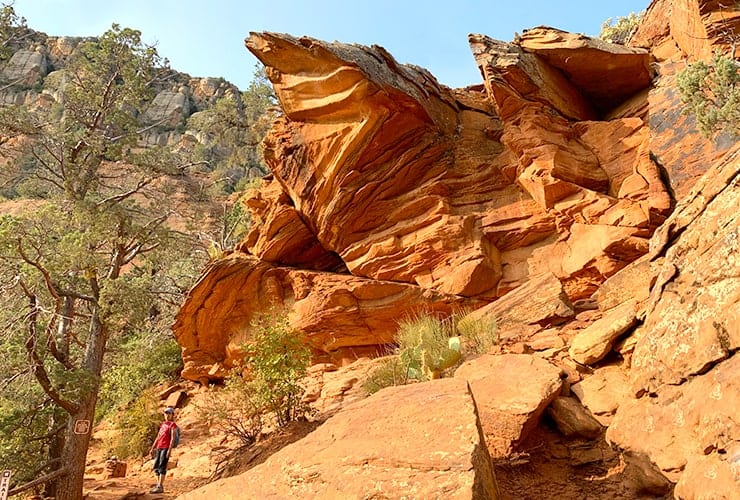
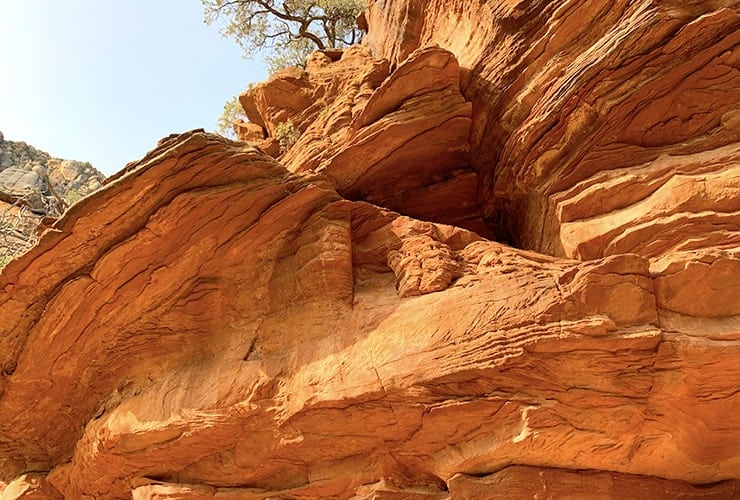
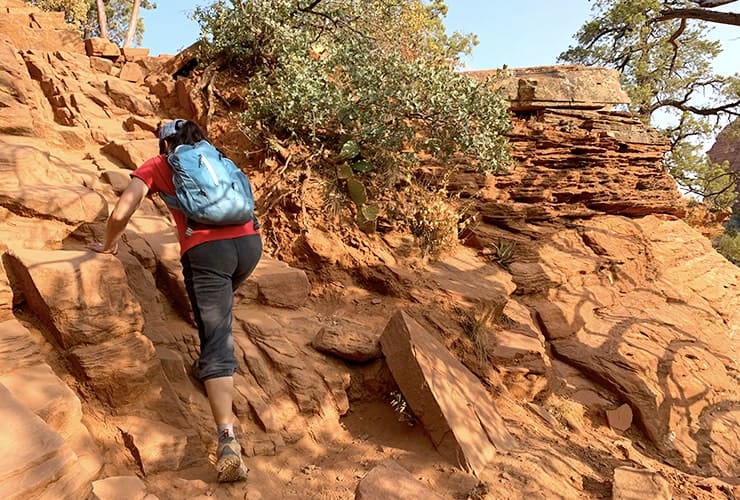
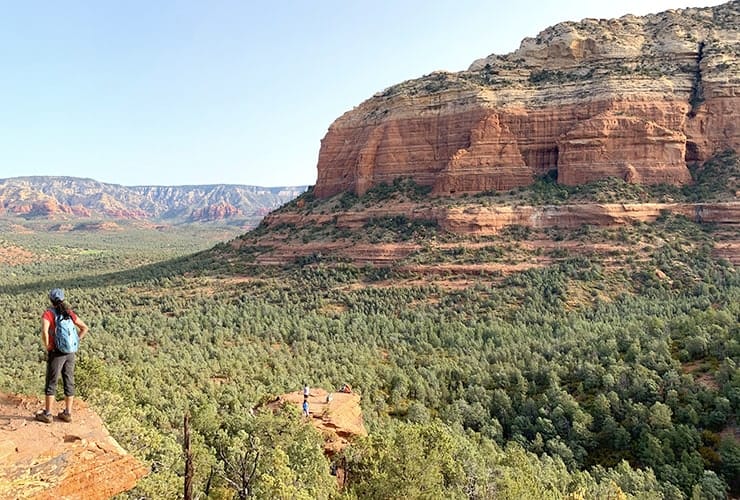
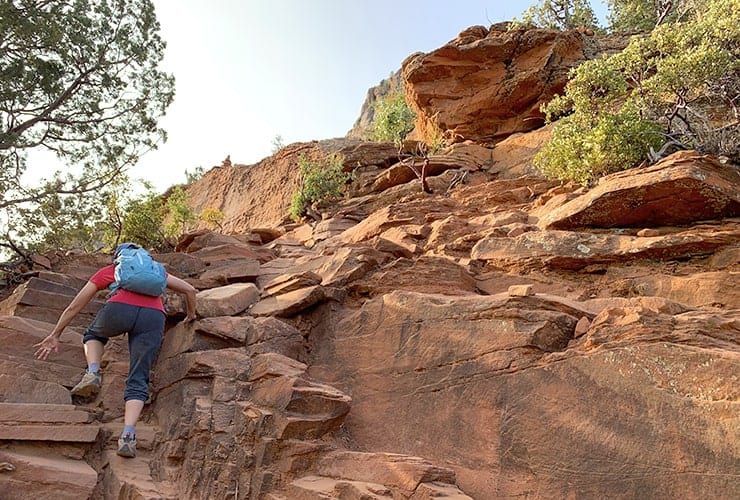
Next comes the more physically challenging portion of the hike but it looks worse than it actually is. One of the first things you see is an amazing bright orange rock to your right that is not just huge but also a study of layers all by itself. Next you ascend a series of steps then rock scramble to another flat lookout area. You can look down and see people standing on the previous lookout area just below. Be sure to keep an eye out for the “PEACE” cairn long the outer edges of the path. Next you continue up steps and scrambles that lead to a flat trail that runs along the rim. A few minutes later you have arrived . . .
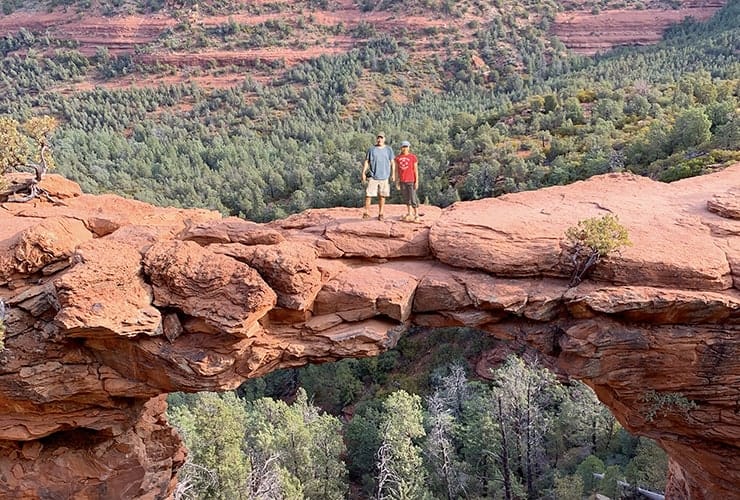
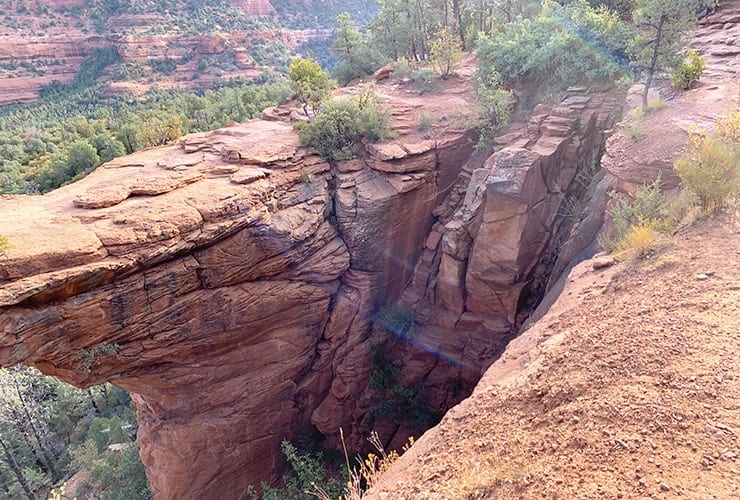
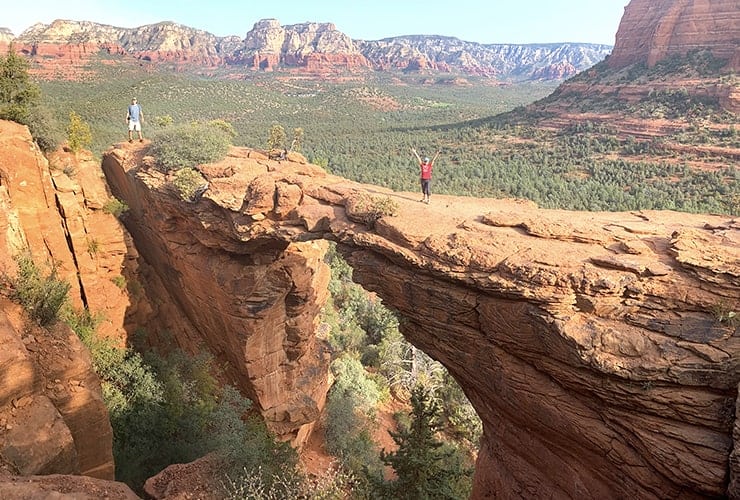
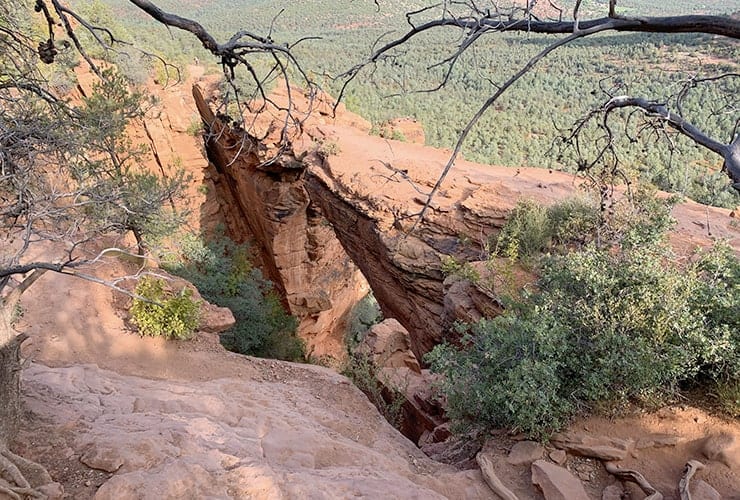
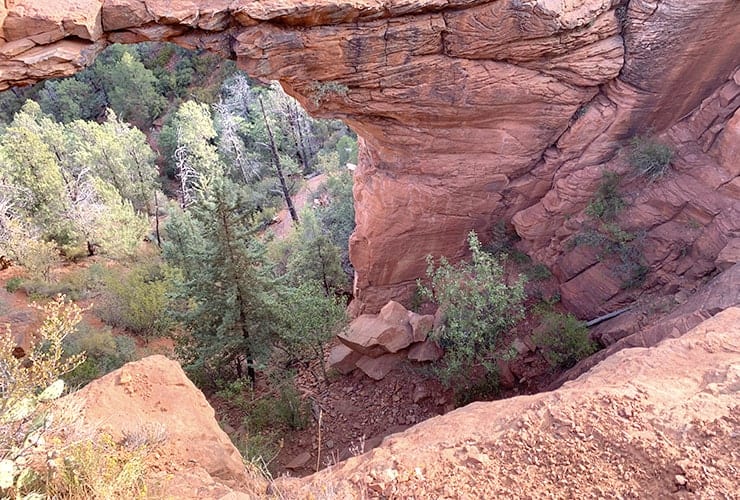
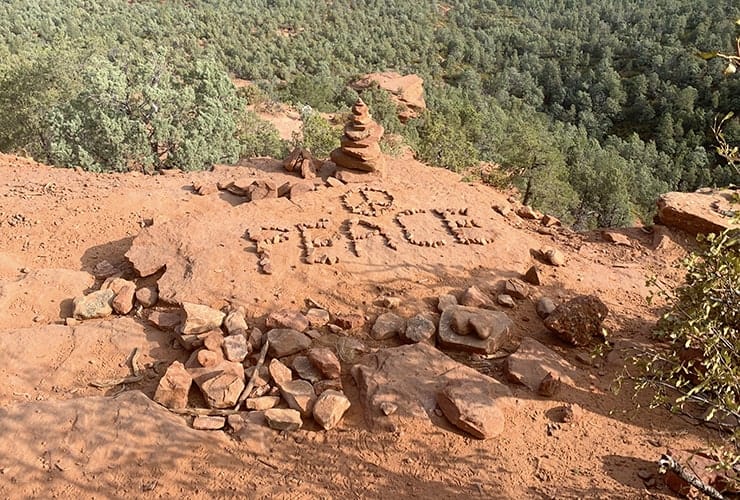
The first thing you notice is the gap just below the arch itself. It is vast and really frames the red rocks of the bridge against the green forests below. Similar to the Natural Bridge at Bryce Canyon, as you walk around the bridge you really appreciate the uniqueness of arches in nature. Just before the beginning of the path out onto the bridge is a little path down about 15’ (4.6 m) that has a flat rock you can lean on to get some interesting views from just below the archway. Walking out onto the bridge looks intimidating from straight on but as you approach the path is much wider in reality. The biggest issue is waiting in line to get your turn on the bridge. Everyone is accommodating and nice but it is still frustrating. After the bridge you go back the way you came.
The best time to hike Devil’s Bridge Trail is early in the morning for several reasons. There isn’t a lot of tree cover so it can get very hot later in the day, it’s a much more peaceful hike due to fewer fellow travelers but, most importantly, the later you arrive at the bridge the longer you have to wait to walk across it alone. We heard of folks waiting hours in line (in the direct sun) just to get their chance. We took off around 6:45 am and our total round trip took about 3 hours so we still had a few hours left in our morning to enjoy before lunchtime.
Best Sedona Hiking Trails Final Thoughts
While there are plenty of fun things to do in Sedona it’s the hiking (plus the views) that really separate it from other vacation options. As mentioned before, there are many more hikes that belong on this list of “best Sedona hiking trails” but these are a great place to start. In fact you could enjoy Sedona without ever having to go on a hike at all.
Please let us know any other hikes you’ve been on or any comments about the magic of Sedona.


